Milanović: Korčula Needs An Airport
ZAGREB, 28 July 2022 - President Zoran Milanović visited the southern Adriatic island of Korčula on Thursday to attend a ceremonial meeting of the Town Council on the occasion of Town Day.
He said that Pelješac Bridge, which was opened on Tuesday, was much more than a transport corridor and more than steel and concrete. "I am very pleased that Pelješac Bridge is here, but I am confident that what you need is an airport. That would work wonders for the island's economy and tourism," the president said.
Speaking of Korčula's tradition, development and beauty, Milanović said: "This tradition, this country and this culture were not created yesterday. This place was civilised, successful and progressive, it was written about. Our islands are like a paradise, this cannot be found anywhere else, so close to the heart of Europe. If you had a bridge, nothing would change here, this would still be a beautiful island. Enjoy your island."
For more, check out our politics section.
2022 Korčula Summer Season Expected to Catch Record 2019
May 26, 2022 - The 2022 Korčula summer season is expected to catch the record 2019, with the return of many cultural events, a revamped ACI marina, and the soon-to-open Pelješac bridge.
Korčula has already recorded an excellent pre-season with figures better than the record 2019. All local governments on the island are growing, bookings are crazy, caterers and renters are satisfied, and a hellish season awaits them, reports Slobodna Dalmacija.
Expectations for a good start to the pre-season in Korčula town have been justified, said the director of the Korčula Tourist Board, Hana Turudić. Compared to April and the first week of May 2019, Korčula has 25 percent fewer arrivals and overnight stays, which are very good numbers and indicators of a successful season, Hana Turudić is convinced. Most guests are still from Croatia and Slovenia, followed by travelers from the USA, Great Britain, and Germany, and markets that have slowed down in the last two years and are looking forward to returning. With no restrictions in place, the possibility of holding numerous events that were called off in the previous two years is now a reality. Following the traditions of the famous Korčula Vela setemana, the 12th Marco Polo Challenge was successfully held, the Croatian Championship in Medium-Long Triathlon, and the Asparagus Festival, Fortress Night, and the Kumpanji Klapa concert on May 1.
"Of great importance are the completed works in the ACI Marina Korčula, which welcomes this season with full capacity and numerous catamaran lines that connect the city of Korčula with Split and Dubrovnik and the islands of Lastovo, Hvar, and Mljet. The Pelješac Bridge opening will be a turning point for further development. In addition, we are announcing numerous events, from the Festival of Knightly Games, classical and popular music concerts, music festivals, the Korčula Baroque Festival and Lost in the Renaissance, food and wine festival Korčula Pjatance, and many other events," announced Turudić.
Lumbarda has recorded excellent numbers, too, and the pre-season recorded an increase of 175 percent in overnight stays compared to last year, but 3 percent more than the pre-pandemic 2019. The director of the Lumbarda Tourist Board, Ante Šestanović, said most guests are Slovenes, followed by the Swiss, French, Norwegians, and Irish. Most of the tourist traffic, more than 41 percent, took place in private accommodation, and they stay for almost a week during the pre-season!
The Municipality of Blato recorded a 25 percent increase in arrivals and overnight stays in the first four months of 2022 compared to 2019. Croats are the most numerous in Blato, followed by Slovenes and guests from BiH and Poland.
"What is worth mentioning is that visitors perceive our island as a destination for a pleasant and quality vacation, and despite all the challenges, expectations for the upcoming season are certainly positive," announced Blato Tourist Board director Maja Separovic.
Several traditional events are planned and held this pre-season at the Blato Tourist Board, starting with the successful traditional gastronomic event Tastes and Scents of the Homeland - Easter Fair in Blato. Then, from mid-May, there are specially designed gastronomic tours for visitors and the local population, to whom they will present local winemakers and producers of traditional lumblija cake.
The Vela Luka Tourist Board director, Dorjan Dragojević, is more than satisfied with the results, especially with overnight stays and arrivals in April, which are 65 percent better than last year.
"Hotel Korkyra has opened, and private accommodation is slowly filling up. Given the good bookings, we expect even better tourist numbers in the future, which we are currently planning at the level of 2019," announced Dragojević.
Although last year's season was excellent for Orebić, this year they are announcing an even better one, primarily due to the Pelješac Bridge opening, and the current figures prove it.
For more on travel in Croatia, follow TCN's dedicated page.
Vela Luka in 48 Hours: Hum, Vela Spila, Martina Bok, and More
May 19, 2022 - Vela Luka, on the island of Korčula, is a popular destination in the summer for those eager to explore the Croatian islands. But even in May, there are many things to do in a short time, with great weather and fewer tourists.
If I blame myself for something in almost three years in Croatia, it is not having explored enough beyond the big cities and the most popular points of interest. The time has come to put excuses aside, the pandemic for example. It's definitely easier to point to a place on the Croatian map and venture out when something strong drives you there. In this case, I felt the need to be alone for a few days and visit a remote place that I had not visited before.
I live in Split, and perhaps the most practical would be to choose somewhere on the islands of Brač, Šolta, Hvar, or Vis. However, my desire to escape was so intense that I felt that these islands were not far enough to satisfy my desires. I saw what other destinations were reachable by sea from the port of Split, and I chose Vela Luka. Interestingly, before I moved to Croatia, Vela Luka was a destination I always browsed on YouTube with my father. For some reason, it caught our attention. Taking that into account and the distance, I didn't think twice.
There are two ways to get to Vela Luka from Split: by catamaran or by ferry. The catamaran is clearly faster, and the journey time is approximately two hours. The ferry, on the other hand, can take up to 3 hours and a half to reach Vela Luka. Something, however, made me opt for the ferry, and that is that in addition to not being in a big hurry, I felt that the size of the ferry offers you better observation points during the journey. My intention was not to sleep during the trip, but rather to take photos, record videos, and enjoy the views, so it makes sense. In case you ever ask yourself the same question, it is worth remembering that the price of the ferry and the catamaran to Vela Luka are the same: 54 kunas.
Leaving Split (First day - 10:30 am)
On a sunny and hot Monday, my ferry left the port of Split at 10:30 am as part of the Split-Vela Luka-Lastovo route. Around 11:15, the ferry crossed the passage between the islands of Brač and Šolta. Fifty minutes later, the ferry would pass in front of the town of Hvar, between the main island and the Pakleni islands. For a while, a thick mist replaced the scorching sun. Finally, at 13:20 pm, the ferry arrived at the port of Vela Luka, where the weather that greeted me was the same or even hotter than that of Split: 24 degrees.

It's not that I travel all the time on ferries, but if the weather is good, you'll never see me inside one. Always on the deck enjoying the landscapes. (Photo: Jose Alfonso Cussianovich)
According to Jadrolinija, the Croatian national ferry company, it would arrive at 14:00 but it was a pleasant surprise to arrive half an hour earlier. It may not be much, but on a short trip that half-hour can really make a difference.
Arriving at Vela Luka (13:30 pm)
I rented a very nice family apartment close to the ferry port but managed to keep the feeling of isolation away from the center. At that time, the first thing I did was check-in, leave my things, and look for something to eat by the riva.

Arriving at Vela Luka. (Photo: Jose Alfonso Cussianovich)
Coming from Split, or recently in Dubrovnik, I was surprised to see so little tourist movement in Vela Luka. I wonder if it was because it was Monday, but it didn't seem to go along with the tourist trends on the coast: silence, some empty restaurants, and bars. It's not something that bothers me, but the opposite. I imagine that in places like Vela Luka, perhaps not as popular as Hvar, Bol, or Korčula, this wave of tourism takes perhaps a few more weeks to manifest itself. If you are one of those who are looking to enjoy a paradisiacal place in solitude, May is your month. If, on the other hand, you want to enjoy Vela Luka at its best, you may want to wait a few weeks for June or July to arrive.
Lunch at Konoba Skalinada (15:30 pm)
The good thing about the location of my apartment was that it was very close to where the Vela Luka boardwalk basically started. That allowed me, perhaps, not to miss a great culinary opportunity along the way. I'm not going to deny that before leaving I took a look at Google Maps for some recommendations, and I was beginning to worry about the number of restaurants that weren't open yet or many that just opened after 5:00 p.m. I couldn't wait two hours for lunch. After walking for about 20 minutes, I found a restaurant that met all the initial parameters: next to the riva, good views, enough shade to protect me from the heat, and, above all, open.
The name of the restaurant was Konoba Skalinada, a family restaurant with more than 10 years of a strong presence on the gastronomic charts of the island of Korčula. As a starter, I ordered a large, ice-cold Karlovačko to think clearly. This is a custom that you will see convenient when summer arrives. I noticed that the restaurant's menu presented an abundant and diverse offer of seafood, and with great sadness, I realized that it would have been a better decision if it had been accompanied due to the enormous number of dishes for more than one person. But that is not a demotivation and much less an obstacle, and therefore I opted for some fried squid. Something told me that any dish is better served on an island, and I was not wrong.
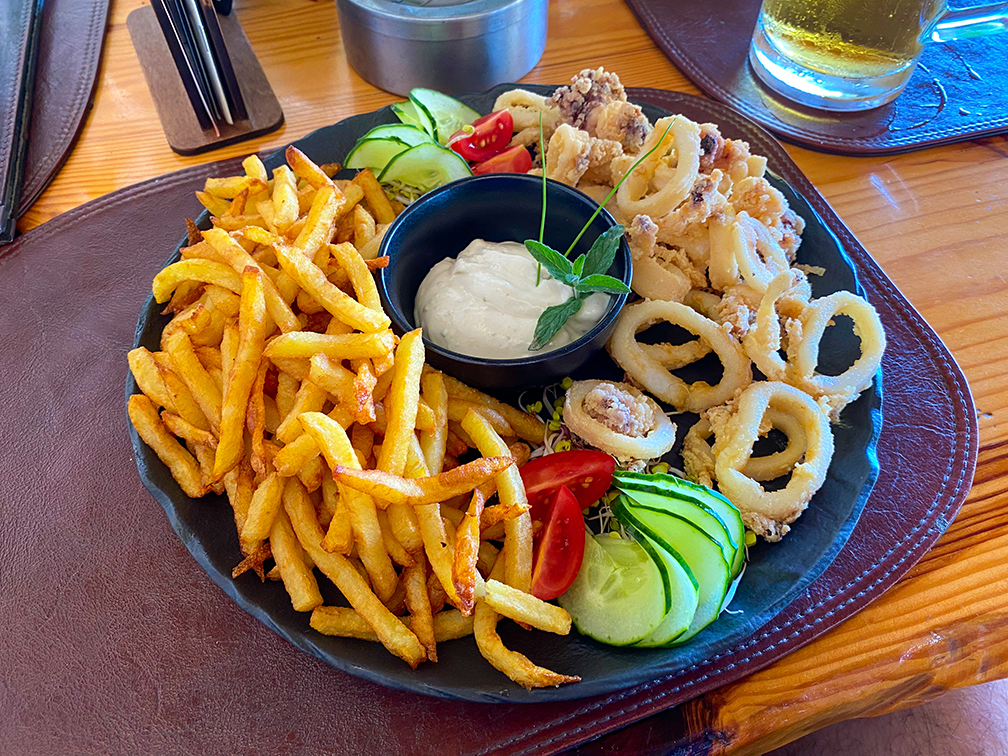
Spectacular food, excellent service, and ''još jedno'' for another Karlovačko did the job. (Photo: Jose Alfonso Cussianovich)
Hiking the hill to Hum (18:00)
I walked back to my apartment to rest for an hour after the heavy lunch and the merciless sun, gather a few things, and embark on my next and last adventure of the day: climbing Hum Hill. From the Korkyra marina on the Vela Luka embankment, it can take about an hour and a half to walk up to Hum. Personally, I recommend doing it either early in the morning with a lot of energy, or in the afternoon after a good rest. I was inclined to go in the afternoon, even without the good rest, since I was curious to see the sunset. The road is suitable for hiking in the summer months, as it passes through shady forests.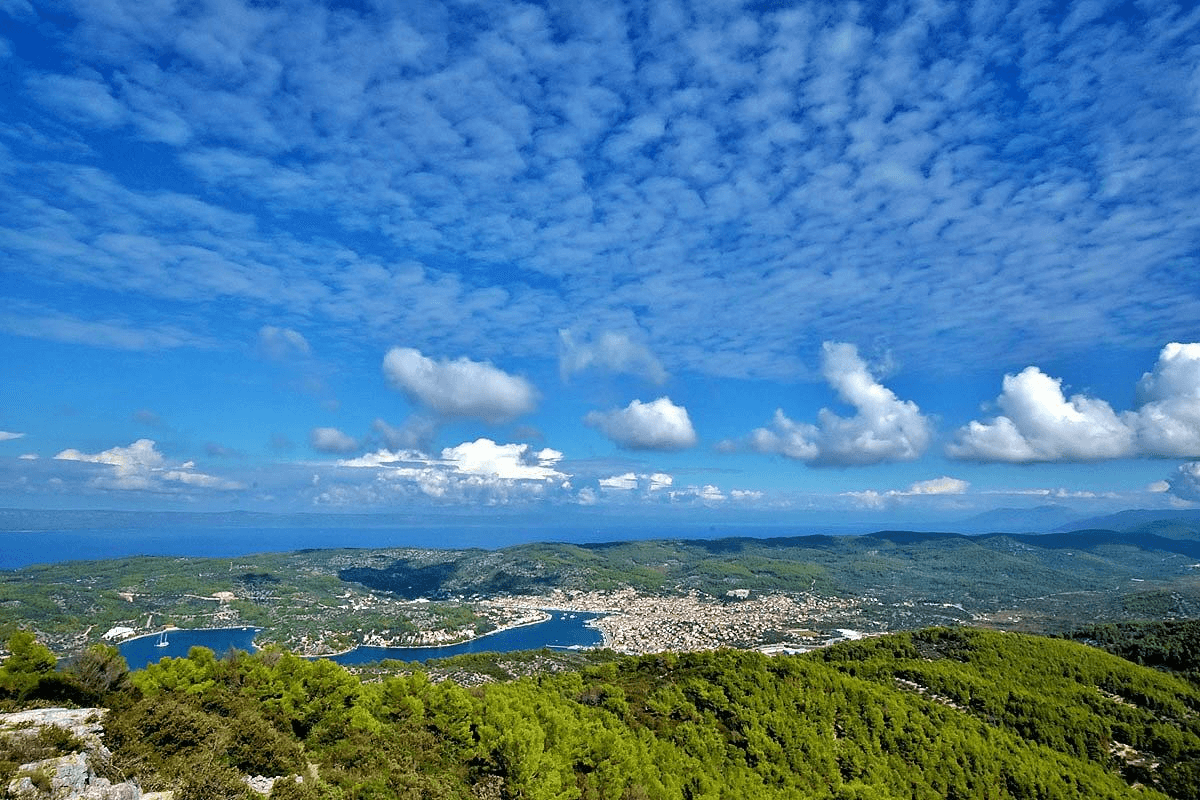
At the top, one encounters not only the Austro-Hungarian fortress of Hum but an unbeatable view of Vela Luka. (Image: Vela Luka Tourist Board)
After returning from the hike, I thought about going back to town for a beer or coffee to close the first day, but I was tired and had a lot planned for the next day. That is why I decided to close the day and sleep early.
Heading to Vela Spila (Second day - 10:30 am)
First on my itinerary for the second day was to visit the famous cave of Vela Spila, located on top of a hill behind Vela Luka's Obala 2. In Vela Luka, you will notice that unlike the vast majority of cities and towns in Croatia, the streets do not have a name, but are identified by numbers. After stopping by the nearest Studenac to buy provisions such as water, bananas, tuna and some crackers, I started the trip.

Most of the old houses in Vela Luka were built between the 19th and 20th centuries. This one is from 1926. (Photo: Jose Alfonso Cussianovich)
I'm not going to deny that it was a bit confusing to find my way around the numbered streets, but it wasn't a problem. Vela Luka, contrary to other Dalmatian cities and towns, does not display Roman heritage and architecture so prominently in its streets and avenues. Although the human presence in the Vela Luka area can be traced back thousands of years, the town of Vela Luka began to develop only at the beginning of the 19th century. However, not having ancient stone houses or churches from centuries ago does not make it less beautiful than other similar destinations.
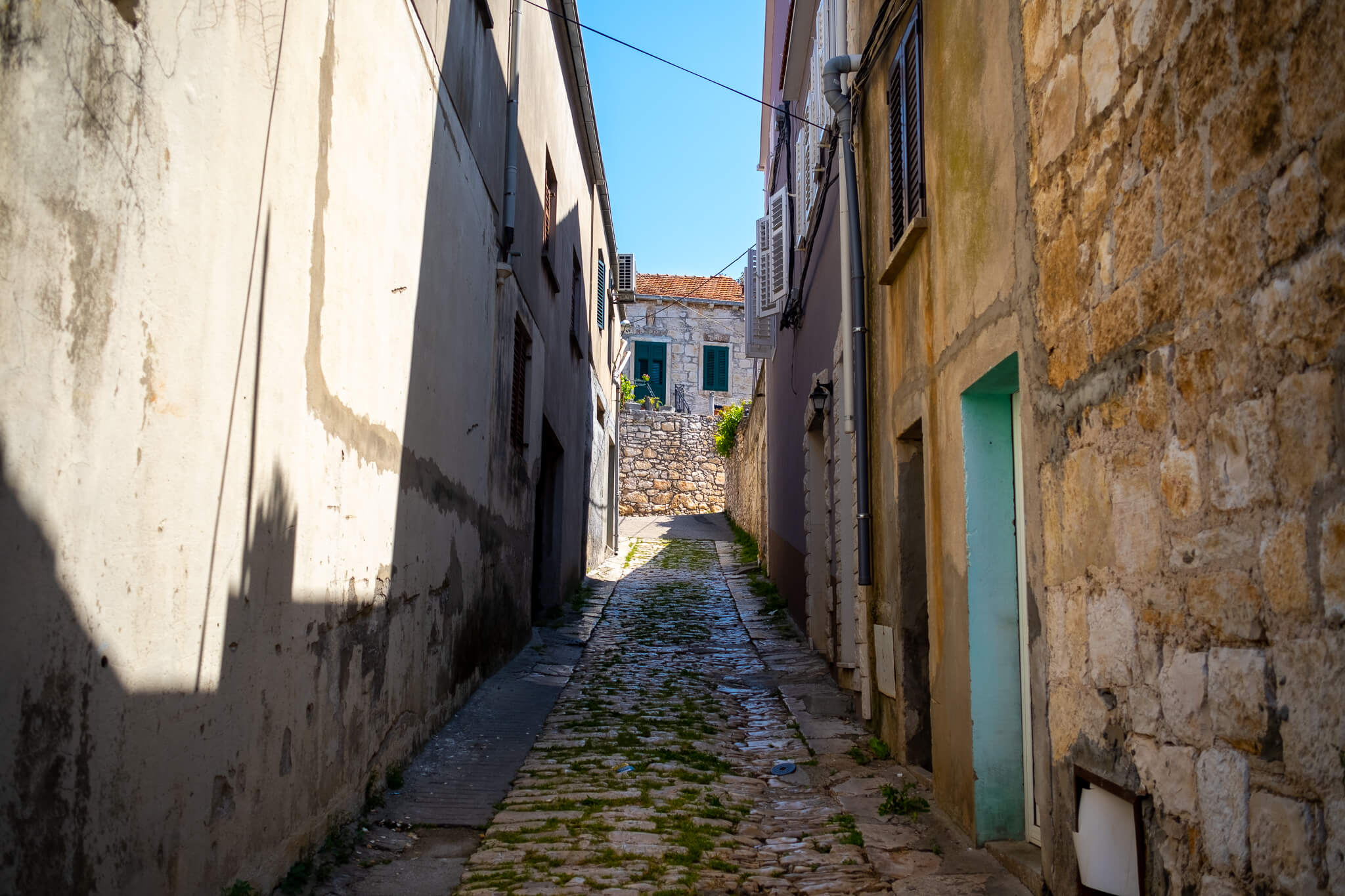
Photo: Jose Alfonso Cussianovich
After correctly locating the 16th street and then a strange steep passage, I managed to find the main track that leads to Vela Spila. After five minutes of walking, you will find a signpost that begins the relatively short uphill walk to Vela Spila. The route is as valuable as the destination, and on the way to Vela Spila you will turn your head as you climb the hill, and you will notice that the view makes everything worthwhile even despite the heat.
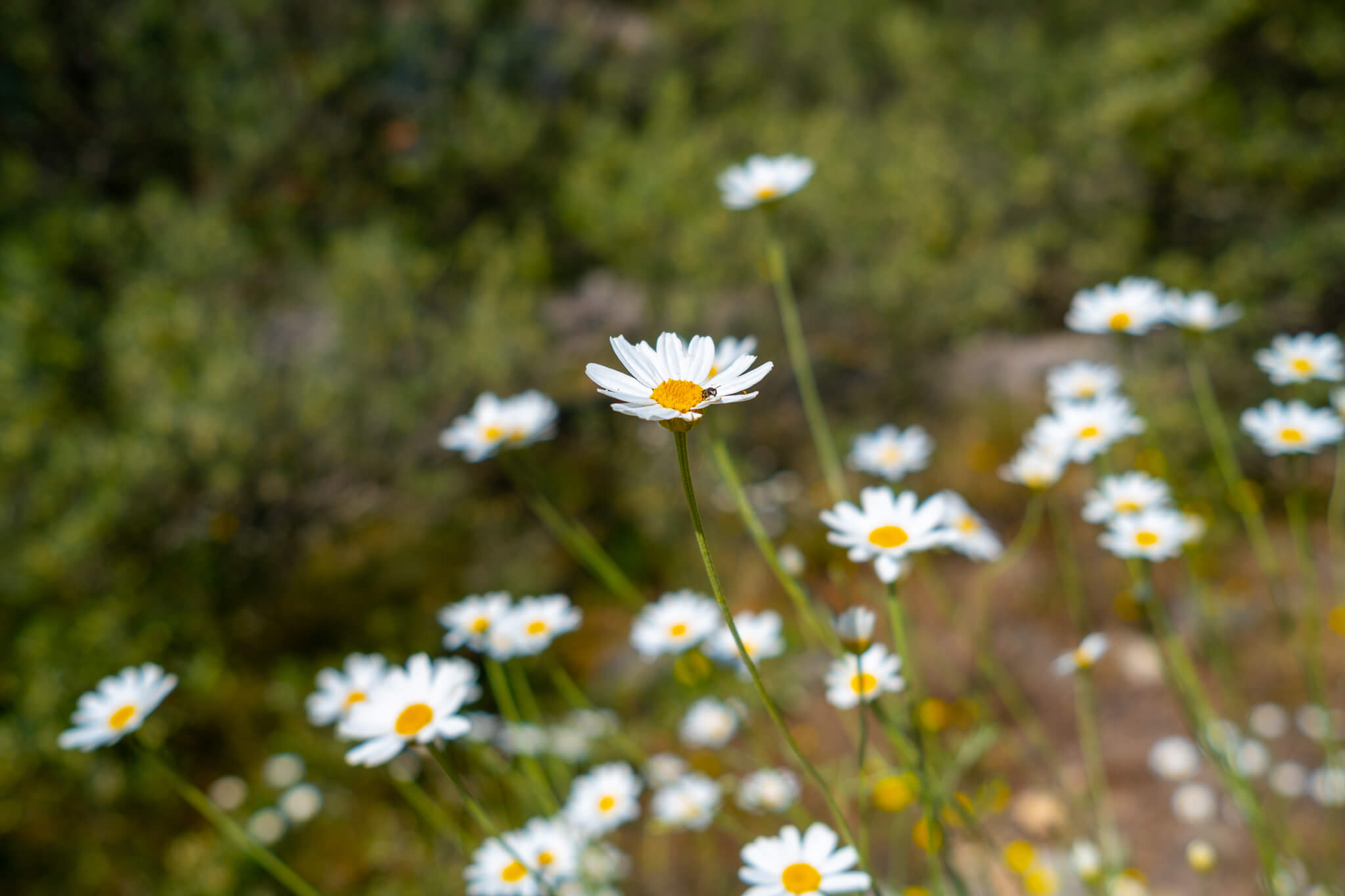
Tansy (Tanacetum cinerariifolium), or Buhač in Croatia. (Photo: Jose Alfonso Cussianovich)
In addition, you will find tansy, a tall and fragrant plant up to 60 cm that decorates the path to Vela Spila and that in the late 19th and early 20th centuries was cultivated in the Vela Luka area as a natural insecticide to care for crops. You'll also notice the presence of carobs, a flowering evergreen tree also known as St. John's Bread, whose sweet, brown fruit has been a part of human nutrition for up to 4,000 years.
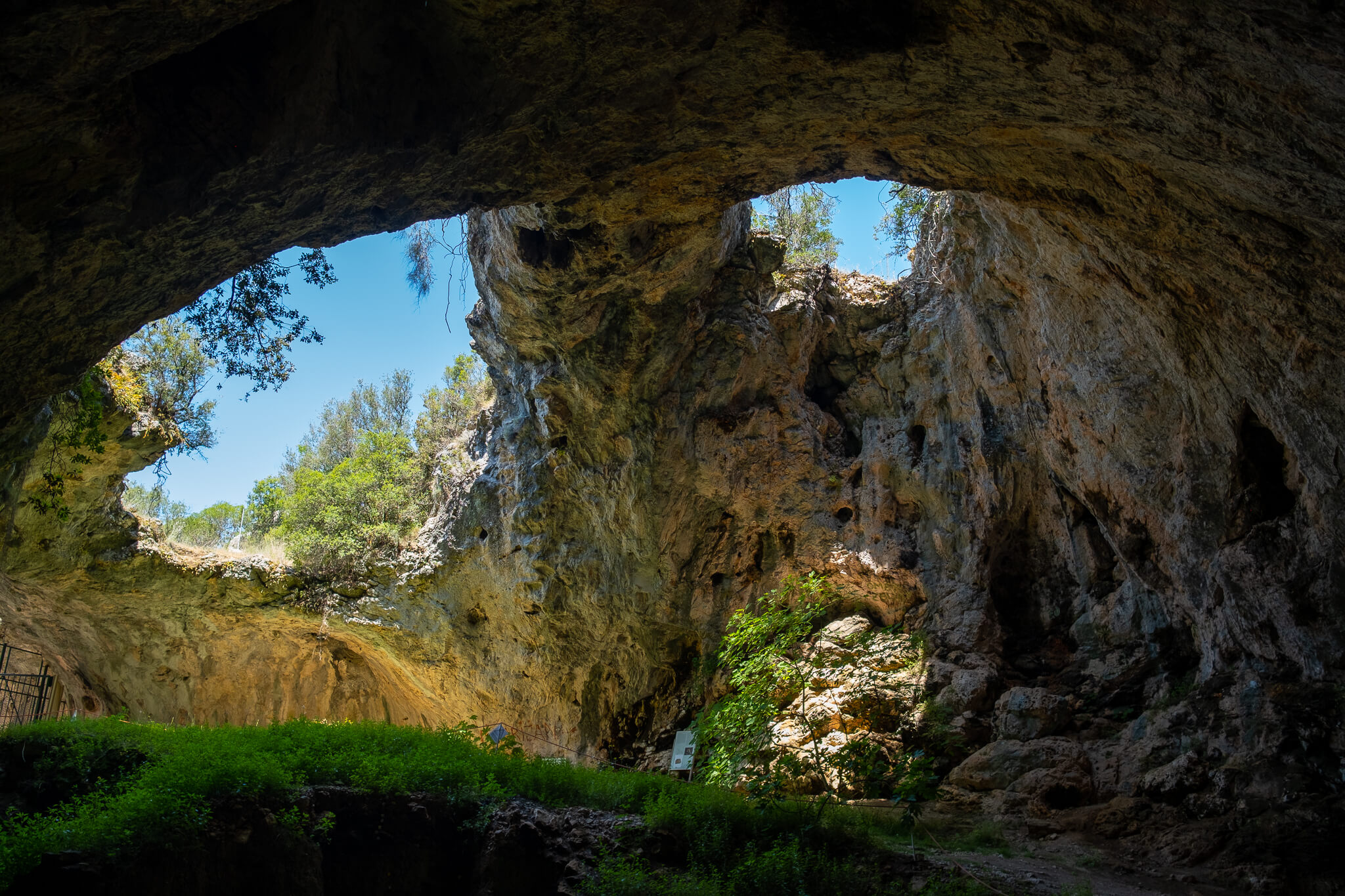
Vela Spila is an enormous lit cave that measures 50x30 meters, 20 meters high with an 8 meters entrance. Archaeological research over the past 50 years, now approximately 11 meters in depth from the original surface, shows its use by early humans from at least 20,000 years ago. (Photo: Jose Alfonso Cussianovich)
Getting to Vela Spila takes about 30 minutes from the center of Vela Luka, and it really is a great idea to include it as part of your itinerary on a sunny day in May or in the summer months. What better way to rest from the heat than in a cave? Even more so if the cave itself is a very important archaeological site, where remains and evidence of human presence in the Old Stone Age were discovered. The cave has only just been excavated to 7.5 meters deep, which leaves one's imagination how much more can be found about even older human habitation.
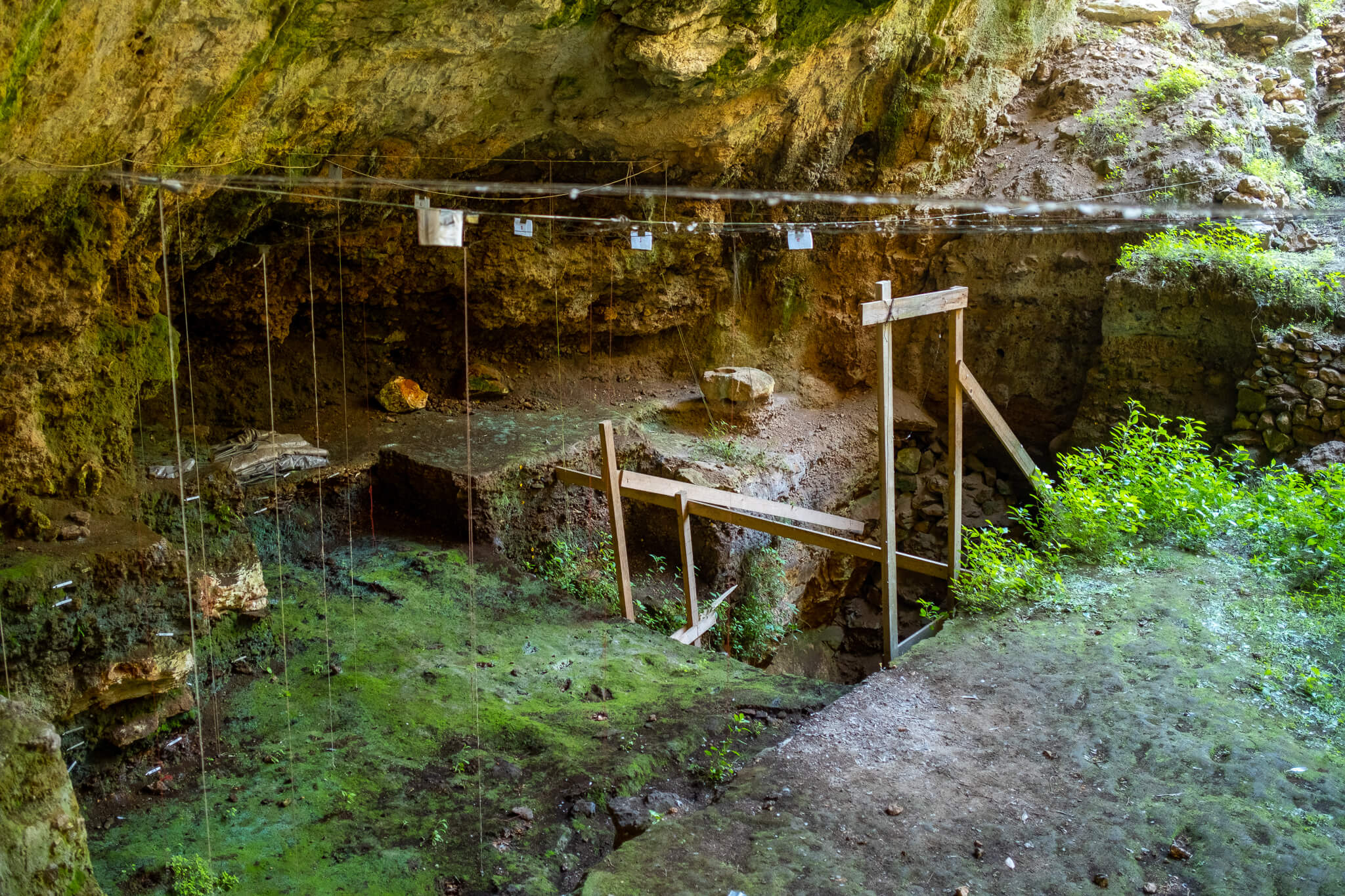
Keep in mind that the entrance fee to Vela Spila costs 15 kunas. (Photo: Jose Alfonso Cussianovich)
Hike to Martina Bok (12:30 pm)
After visiting Vela Spila, it sounds a bit strange not to choose a beach as the next stop on the itinerary. Vela Luka is well known for its countless beaches and coves along the west coast of the island of Korčula. I could have chosen any of the closest to the town, but to make the most of my short stay in Vela Luka, I set my sights on Martina Bok, a beach that is almost 7 kilometers from the center of Vela Luka and to get there a walk of approximately one hour and 45 minutes is needed.
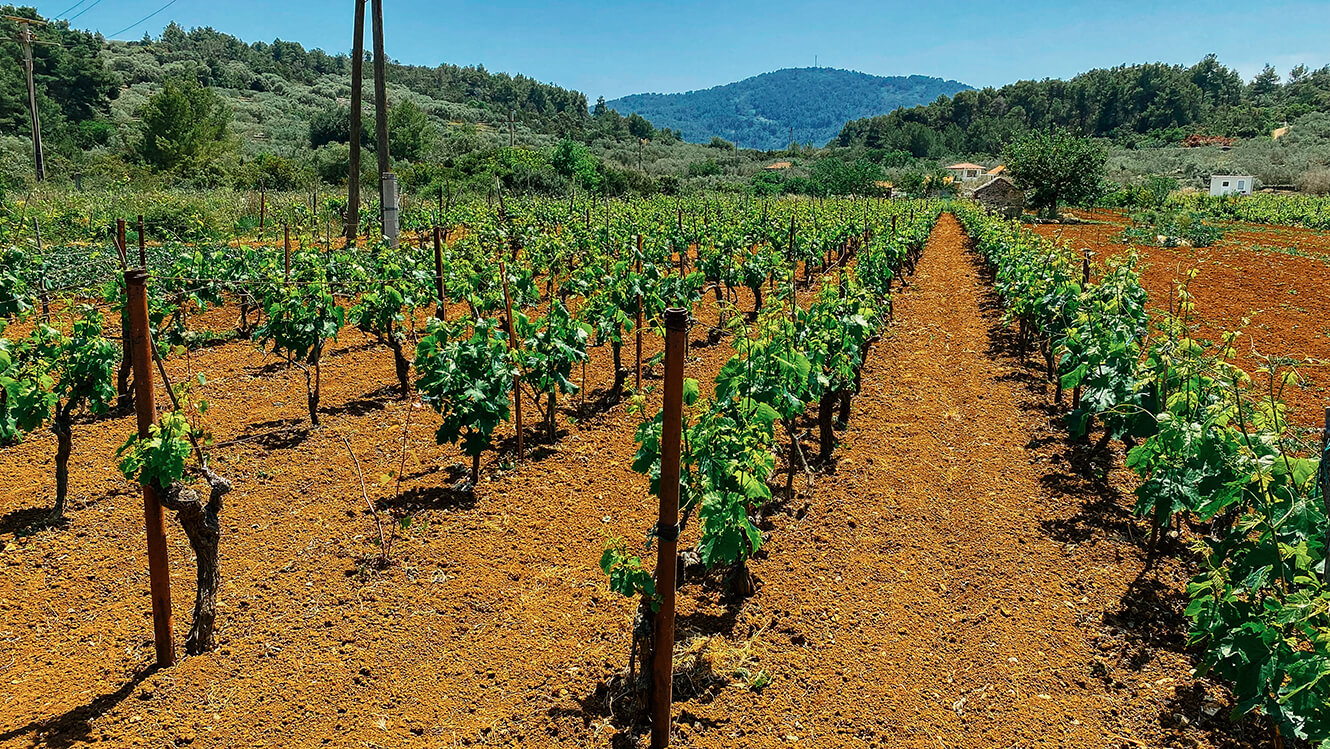
(Photo: Jose Alfonso Cussianovich)
I will anticipate the facts to confirm that it is worth going on foot. Yes, I could have rented a bike or hitched a ride, but I don't know if I could have enjoyed those unique moments alone and pauses to appreciate everything I saw along the way. As well as being a great exercise for one, seeing so many olive trees, vineyards, fields, small old stone houses, and more is priceless. The heat was there, but a cool breeze accompanied me all the way to Martina Bok.
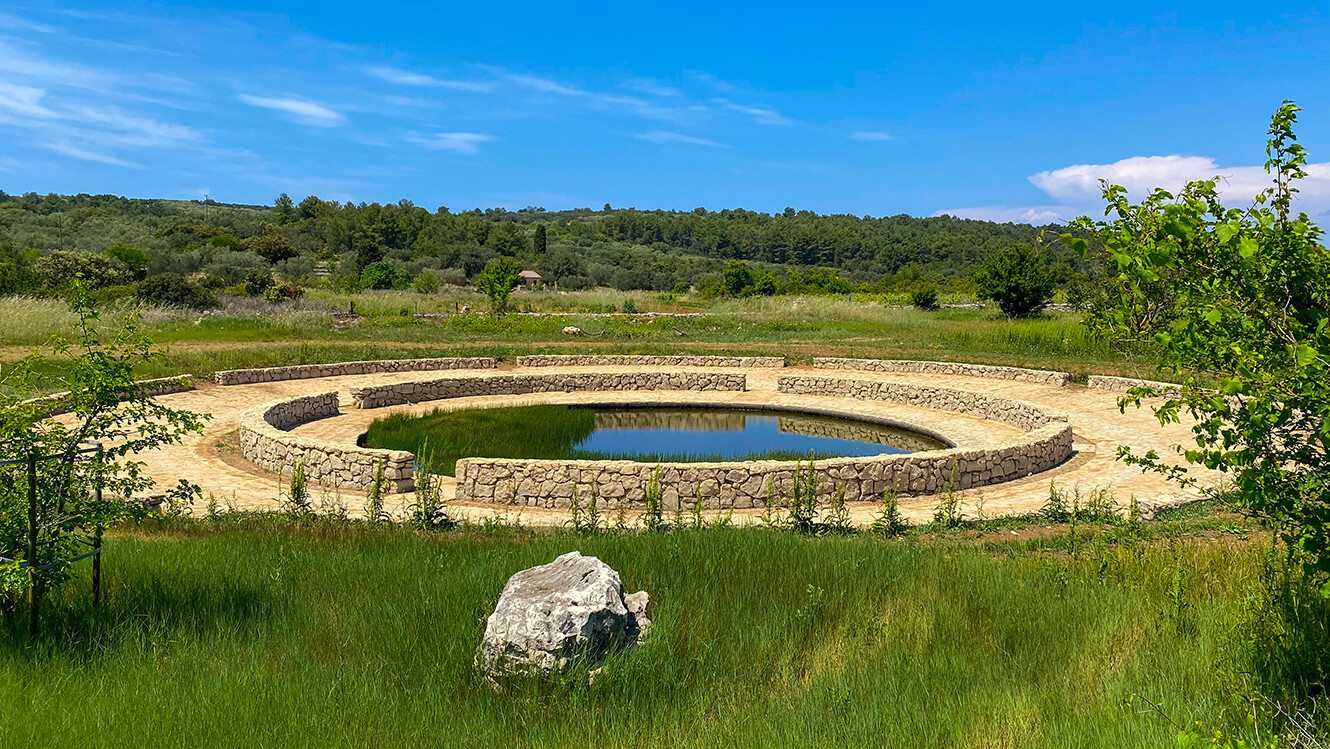
A water reservoir I found on the way to Martina Bok. (Photo: Jose Alfonso Cussianovich)
After an hour and a half of walking, I arrived at the entrance to the beach and it seems to have been naturally prepared to leave one speechless. After crossing a forest of pine and cypress trees, you come across Martina Bok, a beach characterized by its peculiar rock formation, its celestine waters, and the views towards the small island of Šćedro and the island of Hvar. Unbelievably, only one couple was on the beach and they were already coming back. A beach like this and only for me! It wouldn't have bothered me if there were more people, but I remembered that the reason for my trip was to be alone and clear my head, and it seemed that the gods were reading my mind.

Martina Bok. (Photo: Jose Alfonso Cussianovich)
It will not be the ideal beach to lie down and sunbathe, due to the shapes of the rocks, but with the heat and after the long walk that brought me to Martina Bok, I spent more time in the water than out. What pleased me the most was confirming for myself that the temperature of the water is already more than suitable for a dip.
Back in Vela Luka (16:30 pm)
At approximately 15:40 I started the way back to Vela Luka. This time I must admit that I regretted not having any means of transportation to return to town, but I had already assimilated going on foot again. The only thing that worried me was getting too tired to not take advantage of my last night in Vela Luka, but once again it seems that the stars aligned in my favor.
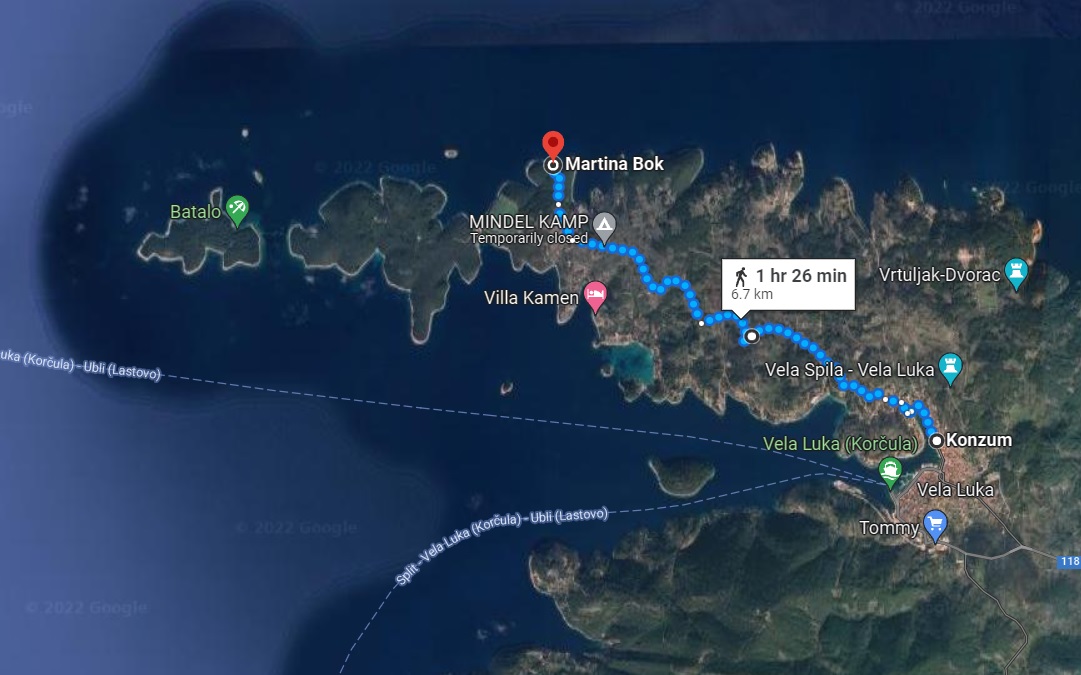
This was my route from Vela Luka to Martina Bok. Beautiful hike, but renting a bike isn't a bad idea!
After walking for half an hour, I heard a car that was going in my direction pull up behind me. I turned around and a lady asked me, "Vela Luka?" With a relieved and almost suffering voice, I replied, "Yes, please." I got on and thanked her for the ride, and I couldn't hide how happy I was to save myself so much time to get back. Her name was Aloisia, a Croatian-German who lives in Hamburg, but every year she returns to Vela Luka, where she grew up, to take refuge in paradise.
The kind-hearted lady dropped me off at the very center of Vela Luka. My plan for the rest of my stay will be simple: go back to the apartment, take a shower, rest a bit, and go back to town for ice cream and watch the sun go down. So it was.
Ice Cream at Diana Gelato (19:00 pm)
On my previous walks, when looking for a place to have lunch on the first day, or when looking for the way to Vela Spila, an ice cream stand with many customers on both days had already caught my attention: Diana Gelato. I mean, again one place ticked all the boxes: location, availability, menu, everything. Once I was sitting there, with a spectacular stracciatella ice cream in my hand and watching the sun disappear, I could say that my brief journey to Vela Luka had concluded satisfactorily.
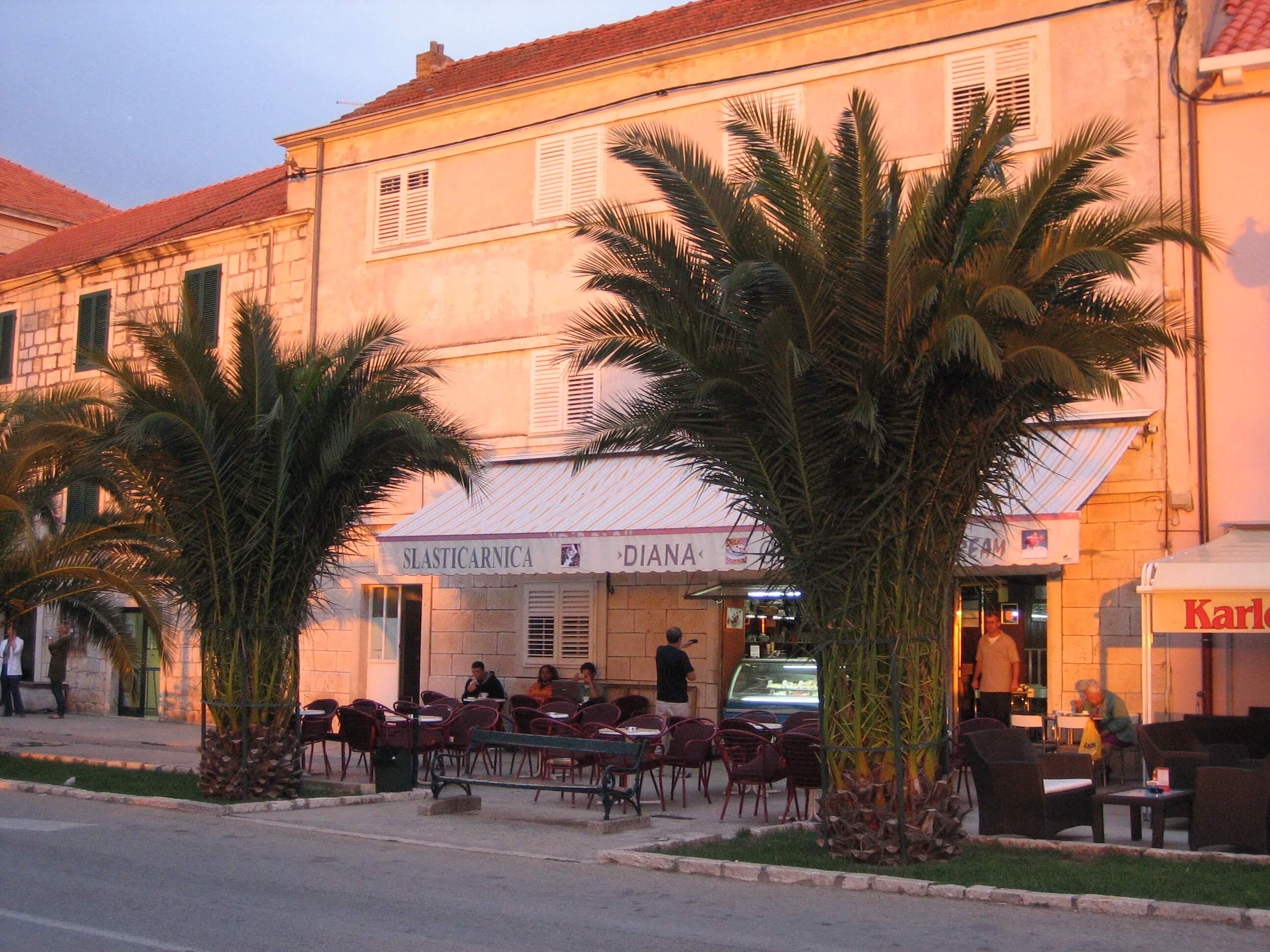
Image: Diana Gelato
The next day I was at 6:05 am in the port of Vela Luka to board the ferry that left 10 minutes later. Definitely, a precious hour to navigate the waters of the Adriatic, and even more so with my head in the right place knowing that I was able to make the most of my time in Vela Luka.

Visiting the islet of Proizd is a must if you go to Vela Luka. (Photo: Jose Alfonso Cussianovich)
Definitely, no destination can be covered in its entirety in just two days, and many activities could not be carried out for reasons beyond my control. For example, there is no trip to Vela Luka without a boat ride to the small and nearby islet of Proizd, famous for its spectacular beaches. Unfortunately, boat services to Proizd are not in service yet. Surely in the coming weeks, as we move further into summer, they will begin to set sail for that islet.
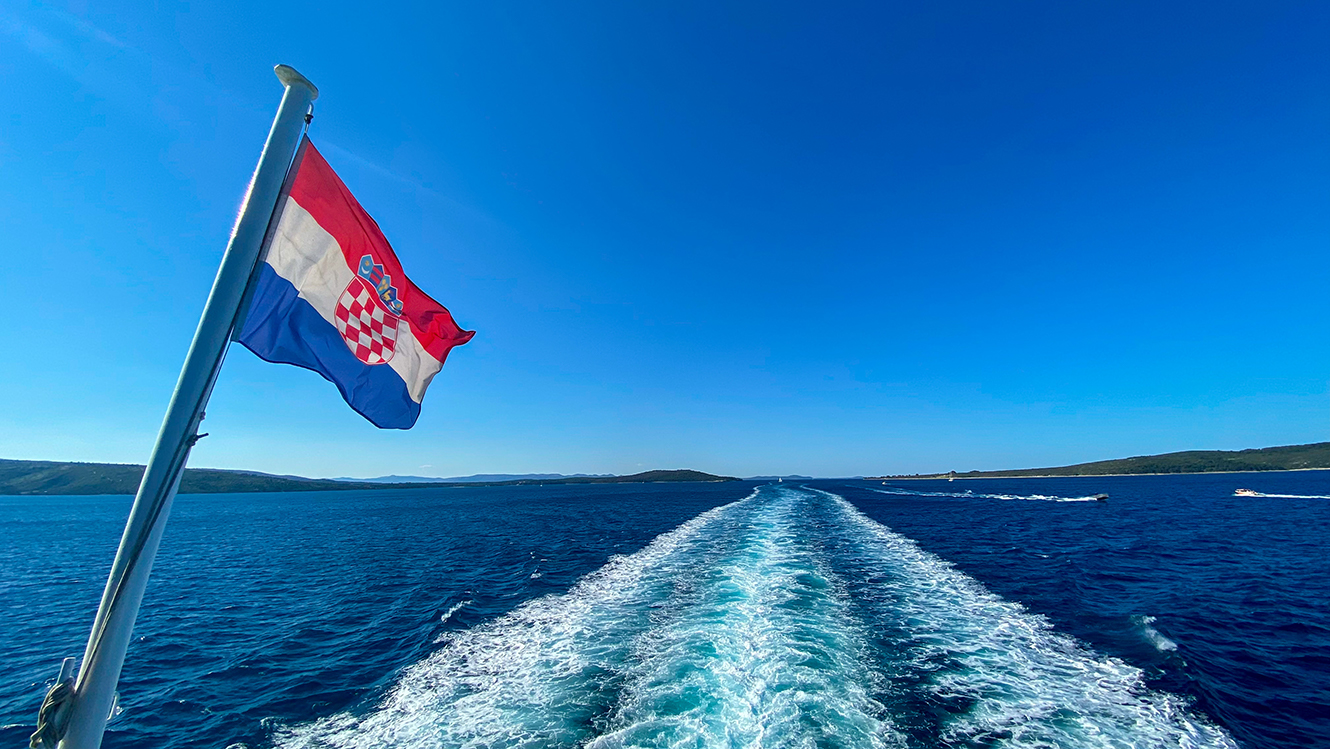
Photo: Jose Alfonso Cussianovich
This was my itinerary, but I'm sure you can be even more creative than me!
For more on travel in Croatia, follow TCN's dedicated page.
VIDEO: New Footage Shows Incomparable Beauty of Korčula Island in Summer
November 13, 2021 – Beautiful beaches, wonderful nature and the atmospheric stone-paved streets of Korčula Town are showcased in this new video of Korčula island in summer
Croatia is known as a sailing paradise. With hundreds of islands and thousands of kilometres of picturesque, historic shorelines to explore, definitely, it is among the prettiest places to discover by boat.
But, ask any sailor where in Croatia is the most beautiful destination to sail to, and those who know will tell you it's Korčula island in summer. The approach to the island - with Korčula Town gradually becoming bigger, more impressive as you draw nearer - is a treat that's unmissable for anyone who enjoys sailing.
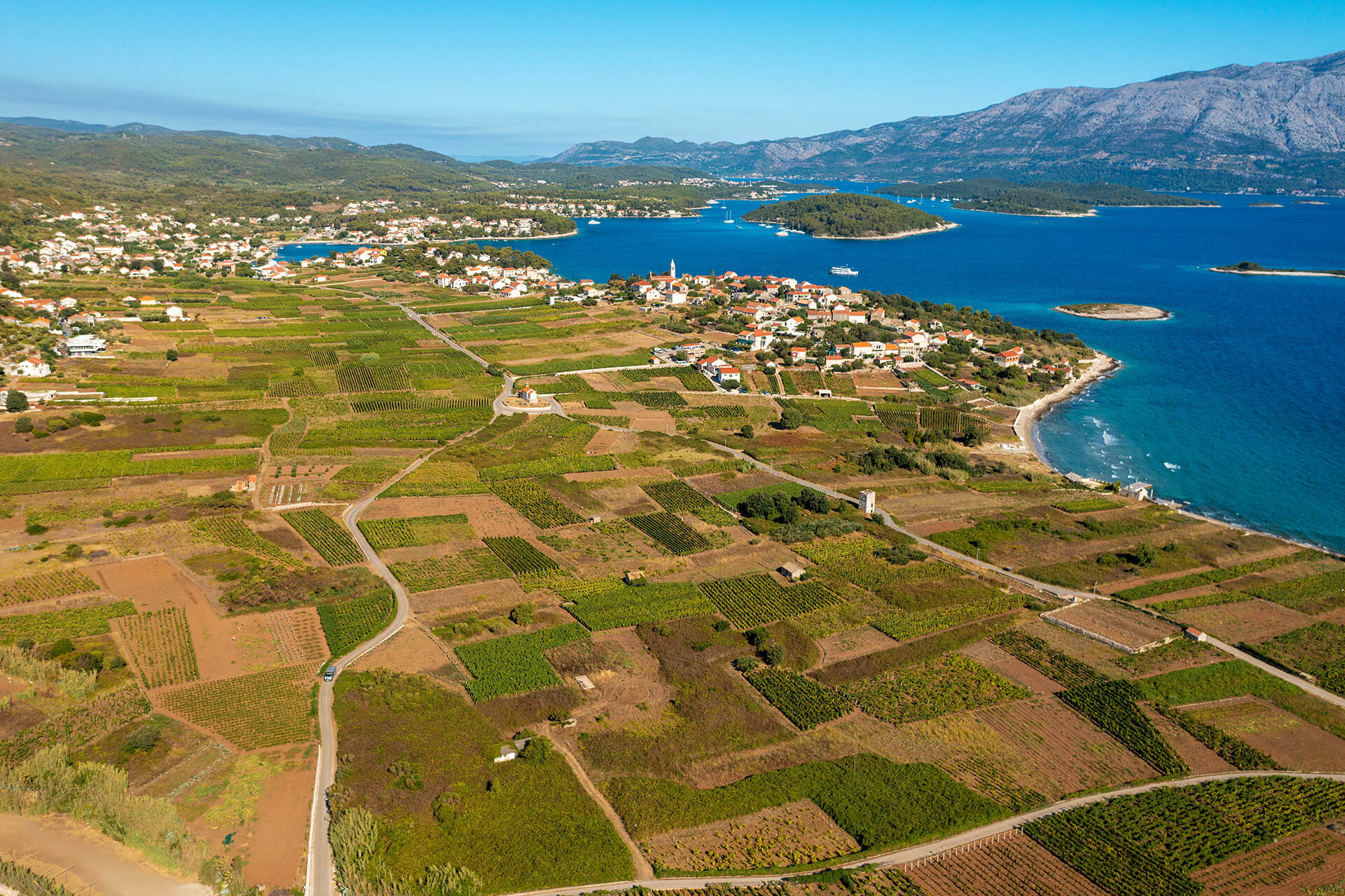 From above, a spectacular panorama shot of Korčula island from summer 2021 © Goran Šafarek
From above, a spectacular panorama shot of Korčula island from summer 2021 © Goran Šafarek
Korčula island in summer doesn't stop being beautiful after you land, as we can see in this new video released by Croatian photographer and video maker Goran Šafarek. The new footage shows us the magical atmosphere of Korčula Town. We are led through its historic stone-paved alleys, past al fresco diners enjoying the long lunchtimes in Korčula's relaxed restaurants and taverns.
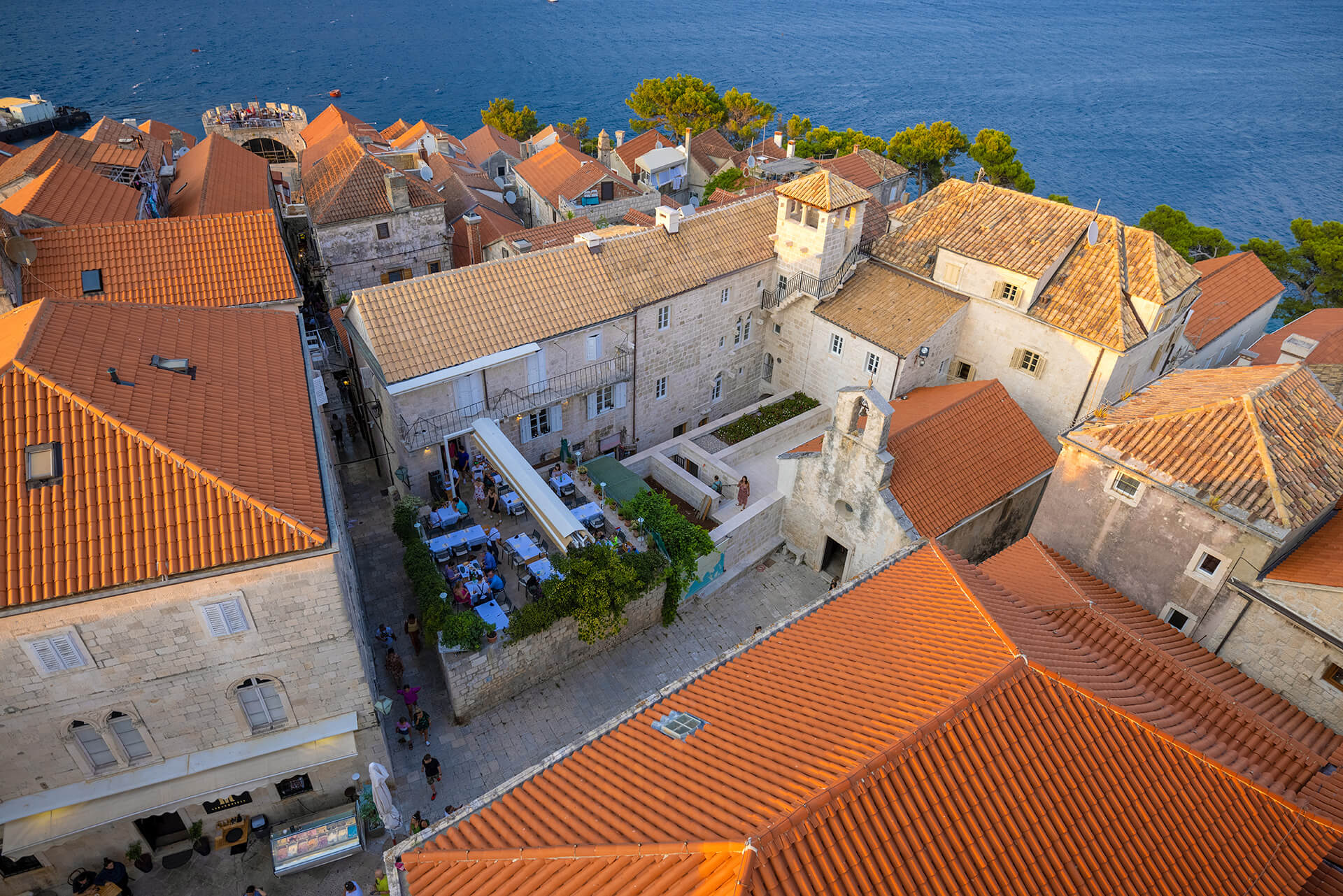 From above Korčula Town in summer 2021 © Goran Šafarek
From above Korčula Town in summer 2021 © Goran Šafarek
Goran Šafarek started his career as a biologist. So, in his new video we see lots of the nature and natural assets of Korčula island in summer. These days, Goran works as an independent biologist, publicist, photographer and filmmaker. He shot the footage for his new video during a trip to Korčula island in summer 2021. You can check it out below.
Both the author and Total Croatia News would like to thank Goran Šafarek for the kind loan of his photography and video to make this article
If you would like to keep up to date with news from Korčula, be sure to see Total Croatia News's tagged pages here
Injured Turtle in Korčula Bay: Rescued, Treated, Ready For New Life
July 17, 2021 - An injured turtle in Korčula Bay sparked immediate action by locals and vets, seeing the turtle being saved and getting a second chance.
Like many other places, towns, locations, and neighborhoods, Korčula also has groups on social media to ease communication among users who share the same place of daily life. Friday afternoon saw residents of Korčula have a big heart, and despite might being stereotypically perceived as laid back, chilled chaps (as for every Mediterranian-culture impacted people), they were quick to act when needed.
A user under the name Antoni Ja, one of the members of the FB group Oglasnik otoka Korčule (Korčula Island Message Board), reported on a 20 kilo turtle floating in the sea in Žrnovska Banja. Floating, the keyword.
„Please do something, so it doesn't get hit by a speedboat or some maniac“, said Antoni Ja.
Other users immediately started to worry if the turtle was injured, and the name of a local vet Vilović was suggested as an address to report the issue.
Sure enough, Vilović examined the turtle, and the 20-kilo turtle turned out to be over 50 kilos. Not quite often seen in shallow waters, but nevertheless a normal turtle size in the Adriatic sea.
„It had a head wound, most likely from the propeller. It is on its way to the Specialist in Split by catamaran“, briefly commented Vilović.
Indeed, as the photo on the FB group published by Ana Jurić shows, the turtle was on its way to Split.
„Kudos to the vet and the guys that organized all this, and the turtle is huge!“ wrote Jurić.
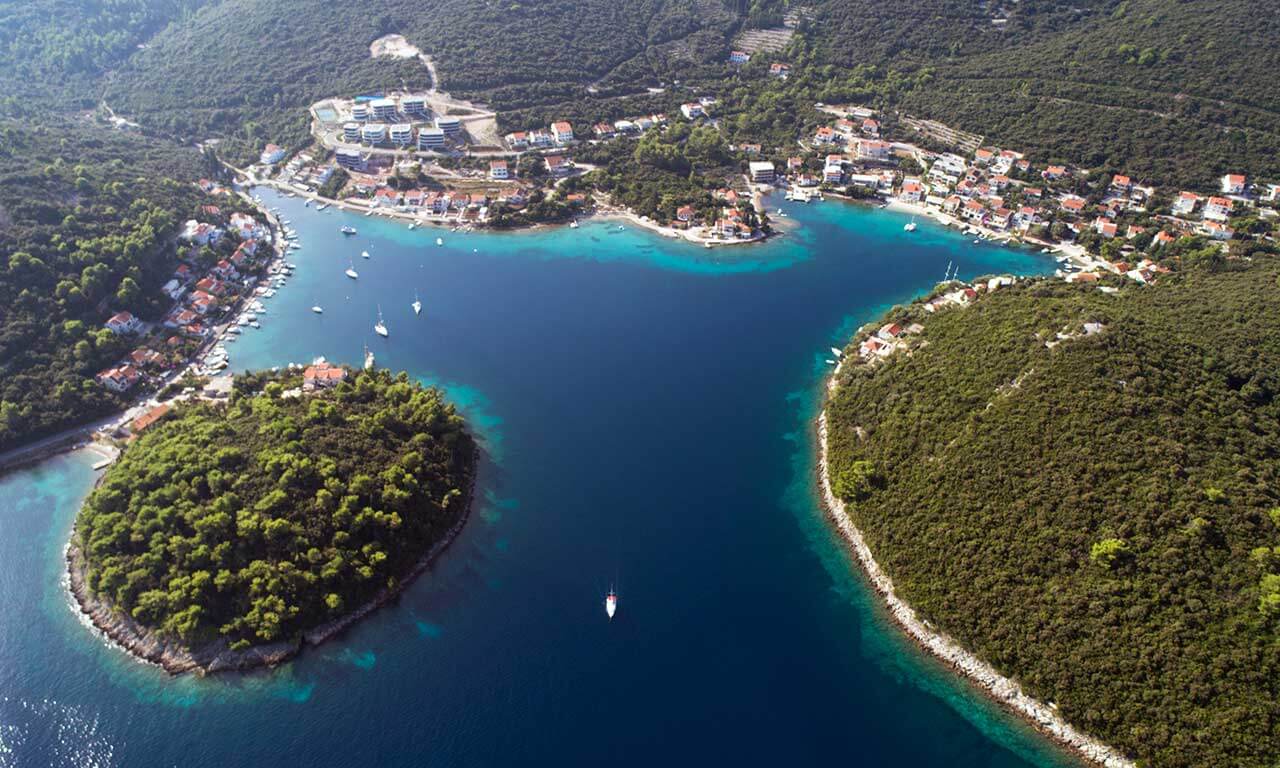
Zrnovska Banja where the turtle was spotted floating © Visit Korcula
Dr. Mario Gavranović, head of the VET VISION clinic in Split, confirmed that the turtle arrived on Friday night. „It should arrive in an hour or two. The propeller injury is an old wound and I will first have to examine it to see what is the proper way of treatment“, said Dr. Gavranović.
When contacted on Saturday morning to provide more information on what happened to the turtle, dr. Gavranović wasn't in his office. As confirmed by Aquarium Pula, the reason was Gavranović took the turtle to the aquarium which also has a Marine turtles rescue centre.
"The turtle is alright, on its way and should be in the Centre around midday", briefly confirmed Aquairum Pula.
Pula's rescue centre has been active for around 17 years (with turtles being strictly protected in Croatia since 1995 as one of the most endangered animal species), and Morski.hr wrote in 2019 how the centre cured over 100 turtles.
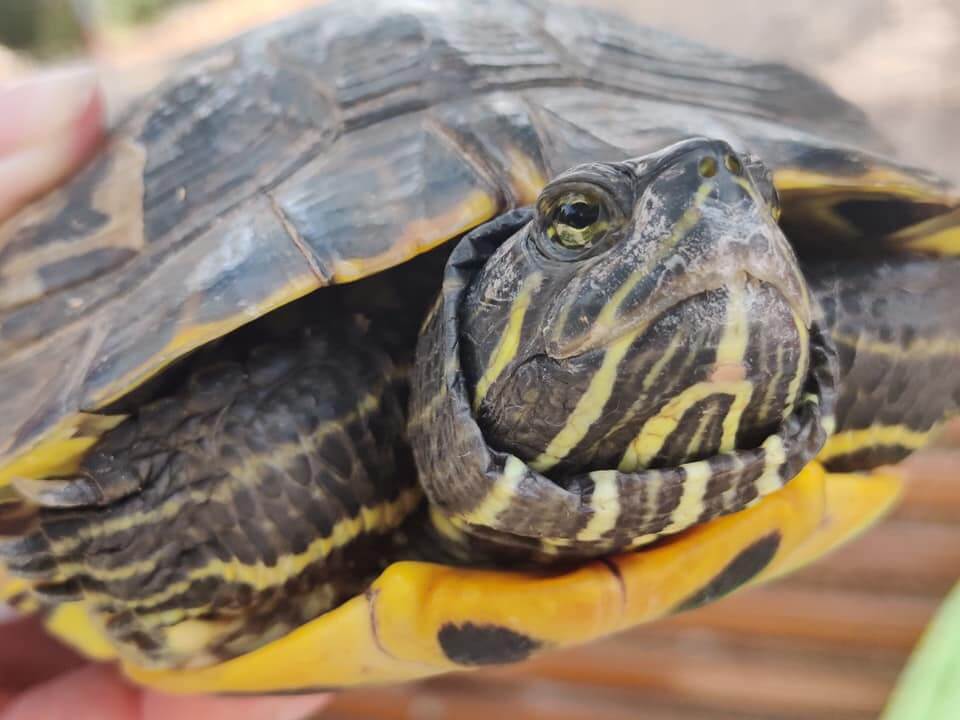
One of the many rescued turtles by Marine turtles rescue centre © Aquarium Pula
Croatia loves its animals
With vets displaying their expertise, locals on Korčula once again demonstrated their compassion and big heart when it comes to animals. And that compassion is not different from the general mood in Croatia.
With the nourishing of the recently deceased stork Malena being the most famous story of love between Croatians and animals, there were plenty of other examples too. From rejoicing every time whales or dolphins are spotted, when sheep visited the Zadar mall or when a Croatian reality TV star Jasmin Kunišinac raised a fox.
Unfortunately, Croatia also records cases of animal cruelty, such as the poisoning of cats and dogs, and each time Croatian public met it with a fierce backlash and anger for such acts.
Despite quite often arguing about everything imaginable and unimaginable, Croatians also express solidarity with each other when things get tough. For instance, many cities canceled their new year celebrations and relocated the money to Petrinja following its earthquake, as well as Croatian entrepreneurs too. But, many more instances of help were noted over the years.
Learn more about Korčula on our TC page.
For more about animals in Croatia, follow TCN's dedicated page.
Korčula Island Label Marks Quality Accommodation and Tourism Services
July 8, 2021 - The new Korčula Island label connects all forms of accommodation and special interest tourism providers with a quality label, all to strengthen the destination.
According to the Project Association of Local Tourist Boards from Korčula Island Agreement (Korčula Tourist Board and the Municipalities of Vela Luka, Blato, Smokvica, and Lumbarda), a Public Invitation was sent for inclusion in the project "Korčula Island," reports HRTurizam.
This is a quality labeling project called "Korčula Island." It is a group of standards and benchmarks that seek to create a new basis for connecting nostalgia of all forms of accommodation and providers of services in tourism of special interest with the quality label. It complements the existing categorization system to increase service quality and competitiveness.
The goals of the project are to increase the quality of the tourist offer of all forms of accommodation, strengthen the visibility of the segment and thus strengthen the destination brand, encourage specialization towards different target groups, diversify tourist products and open new markets, create significant strategic advantages and preconditions for extending the season and encourage establishing partnerships of all stakeholders involved in the process for better cooperation and joint promotion.
The quality label is awarded to stakeholders in tourism from the island of Korčula who have expressed interest in receiving this label for hotels, camps, private accommodation, and travel agencies. Also, sub-brands of this label will be created, such as quality labels for the following categories: “Hikers-friendly,” “Bike-friendly,” and “Eco-friendly.”
The completed application form, together with the documentation from the Public Invitation, must be submitted to the office of the local tourist board no later than August 6, 2021. Find out more about the application HERE.
For everything you need to know about Korčula Island, follow our dedicated Total Croatia page.
For more on travel in Croatia, follow TCN's dedicated page.
Journalist Clickbait Victim: The Curious Case of Mystery Fish on Korčula
June 2, 2021 - When TC editor Iva Tatić caught the fish nobody could identify, TCN reporter Ivor Kruljac jumped to action in the hope he will find a marine life scoop. But after the dramatic realization that Atlantic lizardfish is nothing spectacular, he became a journalist clickbait victim. Meet the mystery fish on Korčula.
It was early evening between 7 pm-8 pm on the eastern Korčula coastline on May 28. After a long week of handling the Total Croatia site, TC editor Iva Tatić decided to chill and went fishing. Instead of managing the multilingual site that brings you the best tips on how to travel and enjoy Croatia, she must've been happy with the idea she can enjoy in Croatia herself, as she was preparing two hooks – one with a squid and the other with the piece of bread. Marine life must be very humble cause instead of a squid (absolutely delicious, either fried or grilled and stuffed with swiss chard), the bread was the taken bait for the careless fish soul underneath the Adriatic surface.
Iva took the opportunity and caught its prey, but pretty soon, happiness for the catch was additionally spiced with curiosity.

the source of curiosity and happiness © Iva Tatić
„What the hell is this?“ Iva asked the local Korčula fishermen showing them her catch.
And „no idea“ was the consensus by other marine life hunters.
„Locals call it the spider“, said a local fisherman known as Pero to Iva. „It looks like Spiderman“.
Iva didn't feel that Spiderman is an accurate comparison, and as no one really knew the answer, the whole thing went online.
After Iva shared the photos of its catch on Facebook, the online jury narrowed the mystery to two possible suspects: Saurida and Atlantic lizardfish.
Still being new and wanting to gain recognition in the newsroom, I took on myself to investigate what exactly is this Aquaman-Spiderman-love-child. Perhaps it's something invasive, a threat to the lovely Adriatic, and a fantastic journalist story.
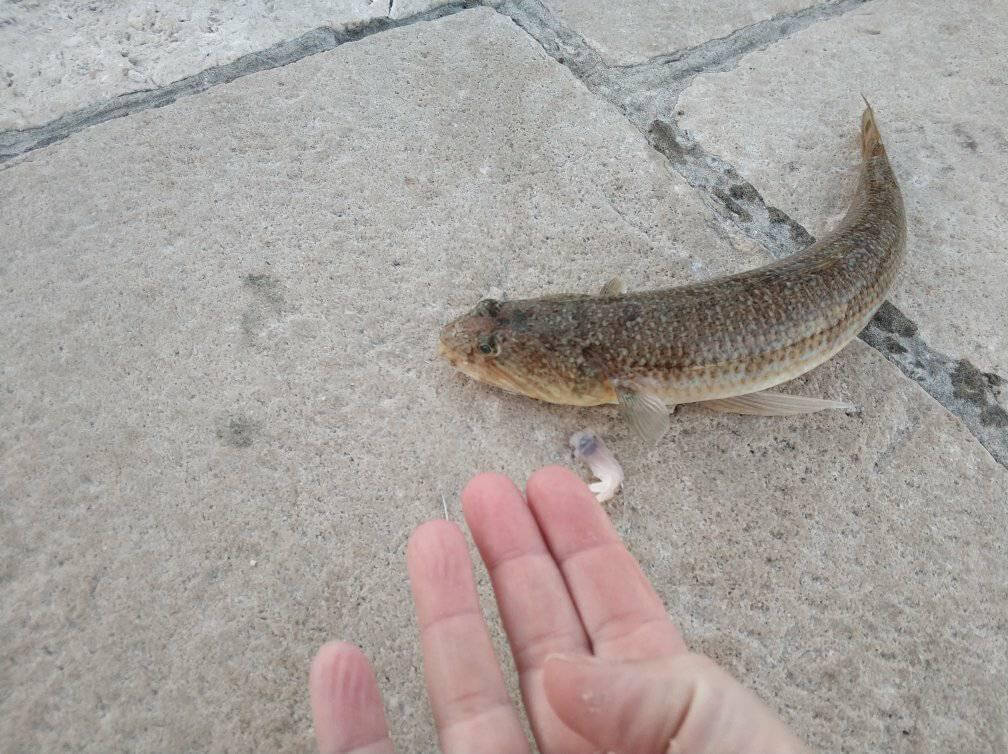
The case, the challenge, the scoop © Iva Tatić
Word on the expert street
A little bit of browsing through the pages of Rovinj Sea Research Centre (CIM), and a few calls, led me to the CIM Senior scientific associate, dr. Andrej Jaklin.
„It looks like Atlantic lizardfish, I saw that fish in person on Pelješac 15 years ago“, said Dr. Jaklin on the phone while looking at the images of the catch I sent him.
Jaklin's memory also seems fit with Pelješac being close to Korčula Island. Still, he said he can't really tell me too much about the fish and recommended it to me to contact dr. Marcelo Kovačić from the Natural History Museum Rijeka. However, dr. Kovačić, a curator for vertebrates, was on vacation, so the call was picked up by Milvana Arko-Pijevac, curator for marine invertebrates.
„I think this could be an Atlantic lizardfish, the head looks like it should, but I'm specialized for invertebrates, mollusks and shellfish“, said Silvana Arko-Pijevac.
So until that point, two experts for marine bio life are certain this is an Atlantic lizardfish (Synodus saurus). Fish, from Atlantic, I thought. Are we talking about an invasive species that manage to come to the northern dead-end of the Mediterranean all the way from the Atlantic? If so, is it hazardous to the domestic sea life of the Adriatic?
Despite recognizing the fish, neither Jaklin nor Arko-Pijevac couldn't say more details, but it's worth noting that the scientific community can once again serve as a role model to everyone who thinks they are experts on everything (both in Croatia but a trend we see spawn worldwide). Instead, my interlocutors accepted and pointed out the limits of their knowledge and suggested me someone who knows more.
Clickbait: It's not just for journalists anymore!
It took me a while to reach Dr. Jakov Dulčić from the Laboratory of Ichthyology and Coastal Fishery at the Institute of Oceanography and Fisheries in Split. First, he was not in the office, and later, he was at a meeting. But, with Arko-Pijevac's claim that Dulčić is the best ichthyologist in all of Croatia, it was worth the wait.
Finally, my mobile phone impulses from Zagreb caught dr. Dulčić in Split, and I excitedly asked him for help. To identify and say a bit more about the mysterious fish fishermen in Korčula failed to recognize, but is suspected to be the Atlantic lizardfish.
„I have to see the photos to say for certain“, said Dulčić.
„I already sent them to your e-mail before this call. Can you please refresh your E-mail?“, I asked with hearable excitement in my voice and suspense in my gut.
The suspense only grew as Dulčić was opening the e-mail.
„Found it!“, he said and I almost screamed out of excitement,
„Yes, indeed, that is the Atlantic lizardfish“, confirmed Dulčić with a relaxed voice while I was ready to ask tons of questions about this weird and possibly invasive species.
„But that is neither exciting nor anything special to catch in the Adriatic“, continued Dulčić with the same chilled tone.
I listened to that sentence with a blank expression fortunately, nobody has seen it except the walls in my apartment.
„You might think it's unusual in Croatian waters because of its name, but it's the normal fish that lives in Adriatic“, added Dulčić.
I couldn't help but think what a sour poetic justice. Being a journalist, a member of the profession in which some of my colleagues try to catch views by clickbait, to be hooked (pun intended) on a clickbait in scientific terminology.
„They can be found across the Adriatic sea, everywhere in Croatia. Their population used to be smaller in the previous years, but it recently got larger. It seems they have certain cycles, but it's nothing spectacular“, he concluded.
„But how come none of the fishermen recognized it?“, I asked puzzled.
„Interestingly enough, it is often caught, but it can rarely be seen on the fish market, and that's a place thanks to which you can usually recognize fish“, explained Dulčić.
However, informing and educating fishers and the general public about marine life in the Adriatic is something dr Dulčić and the Oceanographic Institute are very dedicated to.
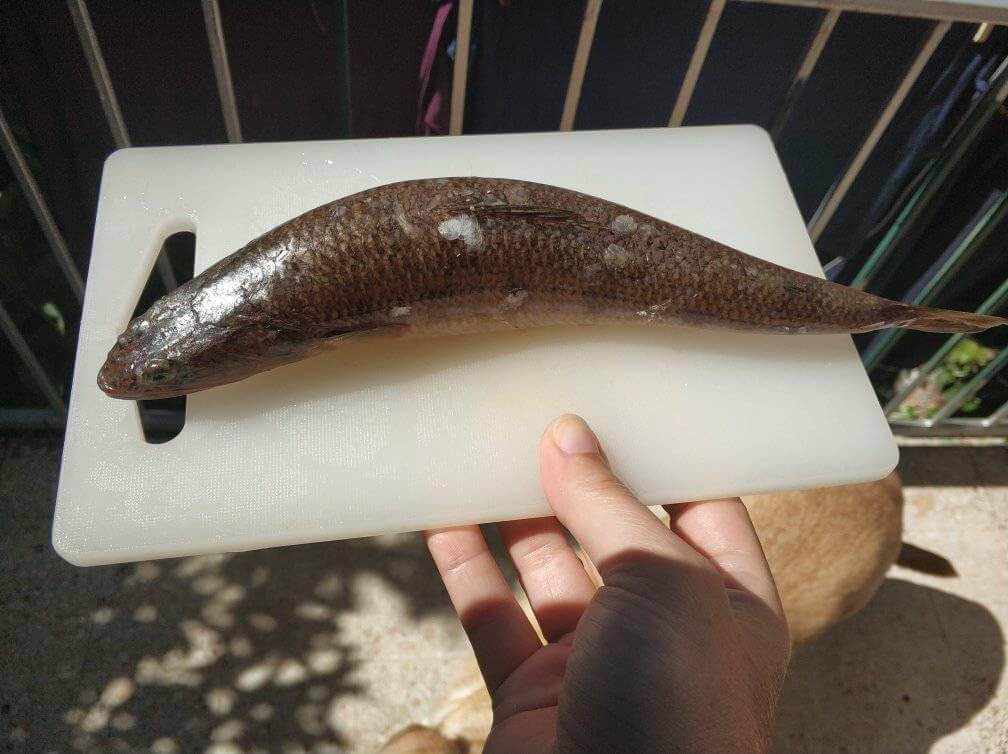
Presenting you the Atlantic lizardfish © Iva Tatić
This is evident by the LEKFishResCRO project.
„This project will address the need to improve knowledge on the trends in Adriatic fisheries with novel methods as well as to acknowledge recent changes in fish biodiversity in a complex Adriatic ecosystem. The central objective of the project will be to evaluate the potential use of the LEK in developing the knowledge base for fisheries management and conservation. The strategy employed for this evaluation will be a two-way discussion between fisherman and other stakeholders from one side and fisheries biologists from another side around the subject of what sorts of indicators of ecosystem health would make sense in light of both the LEK of the fishers and the research-based knowledge (RBK) of the fisheries biologists“, says LEKFishResCRO website, and with loads of materials, you can check yourself.
„We collaborate well with fishermen, we work on their education, and with their tips and images they sent from the field we quickly gather research data“, explained Dulčić.
The invasive species are legitimately a threat to Adriatic, and it comes from the Red Sea through Eastern Mediterranean, but these examples are excellent topics for some other articles.
In the meantime, the mystery fish is identified as a mainstream species in the Adriatic. Somewhat newsworthy (maybe?), but this time my ship returned without a scoop from the stormy cruise in the sea of information.
I sent a message to Iva explaining what she caught (which she already found out on her own, she is a good journalist after all), and I only confirmed that she can unfreeze it and eat it safely. Additionally, I found this recipe at least.
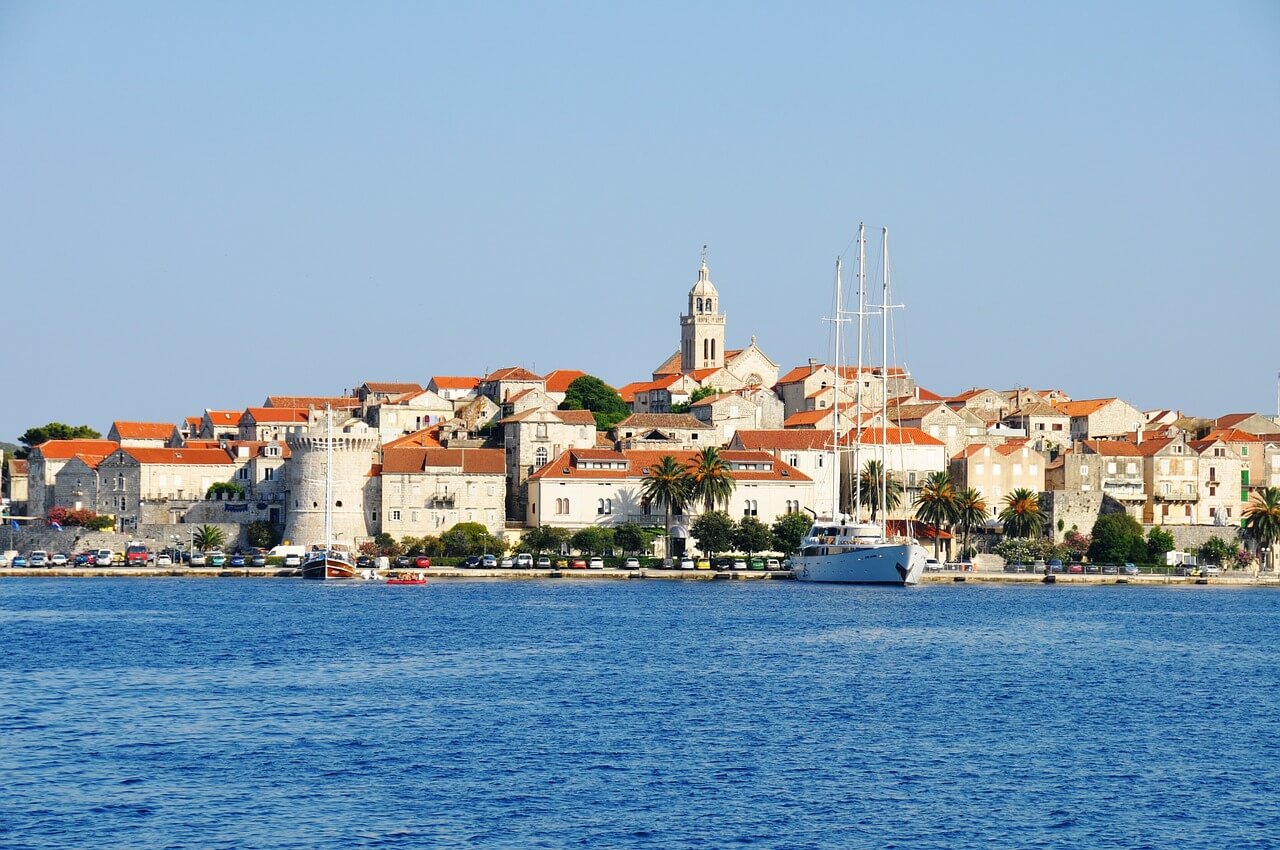
Korčula and Adriatic Sea, Pixabay
Enjoy the Adriatic, but respect marine life
In an attempt to conclude this investigative piece (let's pretend it is one, please) on a socially responsible and eco-friendly note, I asked dr Dulčić if there are any type of fish tourists and locals shouldn't fish because it's on the verge of extinction and if caught it should be returned to the sea immediately. „Such fish is living in areas and conditions where you can't catch it with hooks or nets. But Do not dive out noble pen shells (Pinna nobilis), or disturb mammals such as dolphins. And be careful around sharks and jellyfish“, concluded dr. Dulčić.
Learn more about Korčula on our TC page.
For more about science in Croatia, follow TCN's dedicated page.
Sensational Discovery: 60 Million Year Old Fish Fossils Found on Korcula!
April 13, 2021 – What a sensational discovery! Fish fossils found on Korcula, in Žrnovo, in the hamlet of Postrana, are said to be about 60 million years old!
As Slobodna Dalmacija reports, fossil teeth of fish from the order Pycnodontiformes were discovered in Borovčeva jama. This 43-meter-deep speleological object in the center of the Postrana hamlet was discovered by chance more than two years ago.
Namely, Borovčeva jama was named after Tonči Borovac, who was looking for a suitable place to plant a linden tree when he suddenly discovered the pit.
At the Postrana Local Committee's initiative, the pit was explored by a team of speleologists led by Milan Vojinović from Korčula, a forestry engineer and president of the local society for the promotion and preservation of natural diversity "Adriatica."
During Borovčeva jama's research, fossil fish teeth were discovered, which were recently extracted to the surface, after numerous consents and permits.
"As the renovation of the Korcula City Museum is nearing completion, we decided to take the fossil and include it in the permanent museum exhibition. Obtaining permits for this venture was not easy. Still, we received approvals from the Ministry of Economy and Sustainable Development and the Public Institution for Management of Protected Nature Areas of Dubrovnik-Neretva County. We signed a contract with authorized speleologists to perform works to the pride of the Žrnovo and Postrana residents, and for the benefit of future visitors to the Korčula City Museum," said the Deputy Mayor of Korčula Ivan Šale, a native of Žrnovo.
A depth of 35 meters
But it was harder to pull the fossil out of the pit than to do the paperwork. The pit begins with an awkward narrow entrance. The speleologists descended to a depth of 35 meters, set up a clay hoop, and watered the fossil with a protective rubber, followed by sawing and chiseling of the rock so that the sample could be safely transported to the surface.
It is a Pycnodontiformes fossil, which lived in shallow seas during most of the Mesozoic, spanning 175 million years. Their fossil remains were found worldwide, from the Triassic deposits to the ocean when they became extinct.
They are recognizable by their laterally flattened body and well-developed dentition, which consisted of several rows of rounded teeth with thick enamel surfaces. In short, Pycnodont fish are contemporaries of dinosaurs.
Experts say findings in Croatia are sporadic and limited to Upper Cretaceous sediments along the Adriatic coast. The most common species is Coelodus saturnus, found in localities from Pula to Brač. Some of the specimens from this group of extinct fish are kept in the Croatian Museum of Natural History.
The speleology instructor Branko Jalžić, who, together with his colleague Damir Basar removed the fossil from the Postrana pit, confirmed that this finding would be a valuable part of the Korčula museum exhibition.
Valuable proof and important scientific data
"The project was well-received by all participants, as always when we do underground research on Korcula. We completed the task successfully, the fossil was handed over to the Croatian Museum of Natural History, and it will be returned to Korcula after processing. There is no space in the museum to exhibit a more extensive story from that period, and that is why this small segment will be an important part of the future exhibition. Given the small number of fossils of pycnodont fish, each new find, including this one from Korčula, is a valuable proof of their distribution and important scientific data," explained Jalžić.
He thanked the City of Korcula, the company 'Adriatica,' and the Voluntary Fire Brigade of Korčula, which gave them rooms for sleeping and rest. Many thanks go to Tonči Borovac, who gave them a technique they did not have or they did not have to bring from Zagreb to the island.
He also thank the Public Institution for the Management of Protected Nature Areas of the Dubrovnik-Neretva County, which financed the project and without whose support they would not be able to stay on Korcula.
Not the first fossil found on Korcula
However, this is not the first time speleologists discovered old fish teeth fossils on Korcula. Branko Jalžić, a member of the Croatian bio-speleology society, was a part of a cave research team back in 2018 that found fossil fish teeth at least 100 million years old. The teeth were also found in the same pit, Borovčeva jama. This fish probably lived in this area in the Cretaceous period and belonged to a group called bony fish.
They then discovered a total of three fossils, and in the 80s, the bones of a fossil rhino were found on the island of Korcula.

Fossil fish teeth found in Borovčeva jama on Korčula in 2018 / Adipa.hr
To read more news from Croatia, follow our dedicated page.
Croatia Filming Locations Are Best Again As Succession Bags 7 Emmys
September 23, 2020 – Following incredible success with Game Of Thrones, Mamma Mia and others, Croatia filming locations prove to be the best again as HBO's Succession wins 7 Emmys
Historic Dubrovnik was always pretty enough to attract people from far and wide. Dubrovnik has a lot of sights to visit. In addition, it offers many activities such as hiking, cycling, sailing, boat ride, Seabob experience etc. But, following its appearance in TV show Game Of Thrones, interest in visiting the walled city went through the roof. Tourists were not the only ones who wanted to come.
HBO drama Succession is just the latest hit to take advantage of the spectacular scenery while filming in Croatia. The show has just bagged no less than seven prestigious Emmy awards for the season partially filmed in Croatia. In the drama series category, it picked up Emmys for Best Leading Male Role, Best Guest Role, Best Casting, Best Directing, Best Screenplay and Best Picture Editing.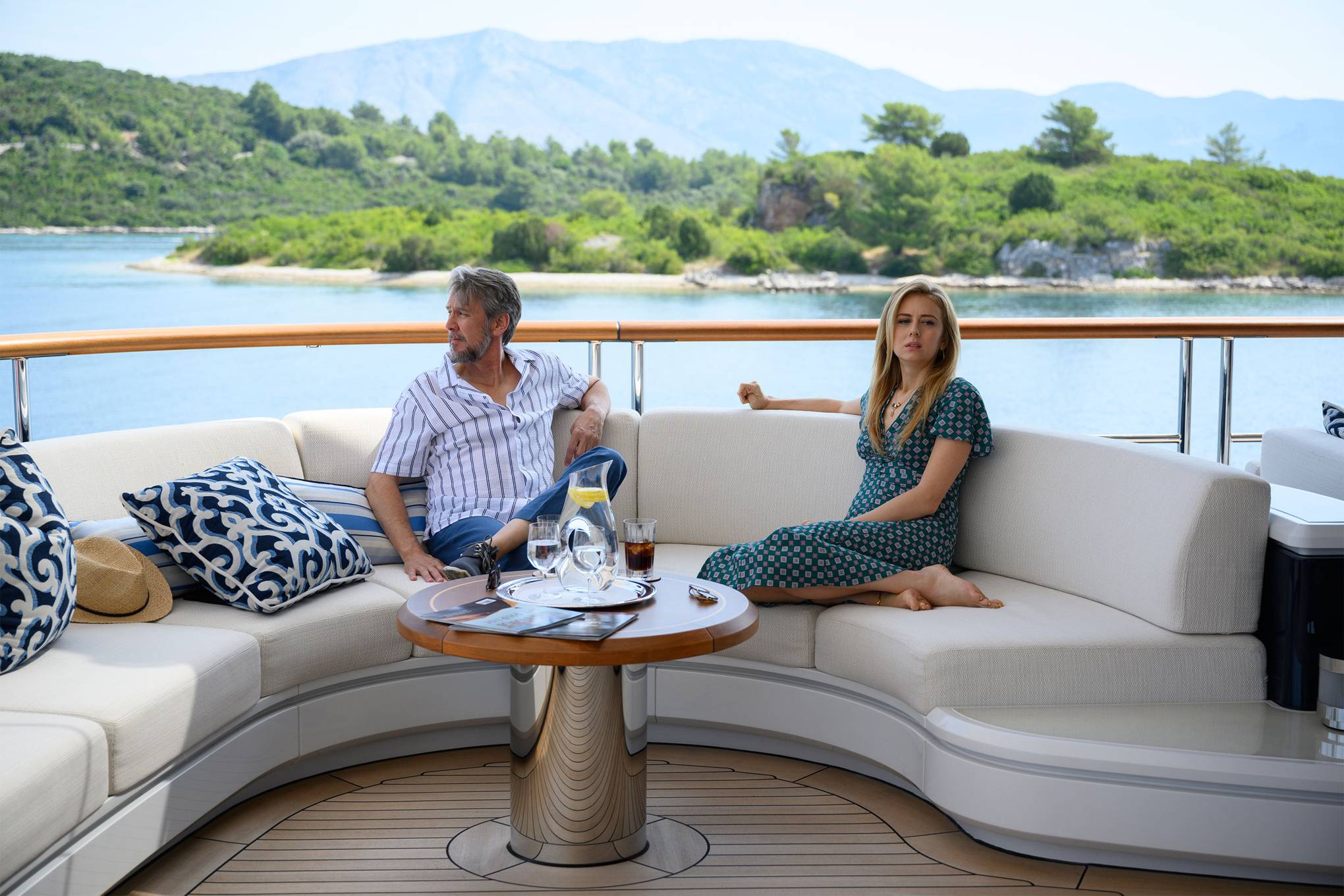 Cast members filmed aboard a yacht with beautiful Croatia and its Adriatic waters as the backdrop © HBO
Cast members filmed aboard a yacht with beautiful Croatia and its Adriatic waters as the backdrop © HBO
The shooting took place over 12 days in July 2019, primarily on a yacht on which the show's central characters, the Roy family, were taking a holiday. The Croatia filming locations used were the waters around Cavtat, Korcula, Mljet and Sipan. The series ventured into more urban areas of Croatia and, for those scenes, filming locations in Zagreb and Rijeka were sourced. The German-built Solandge was the yacht used in the filming and costs as much as $1.1million (£850,000) to rent for one week.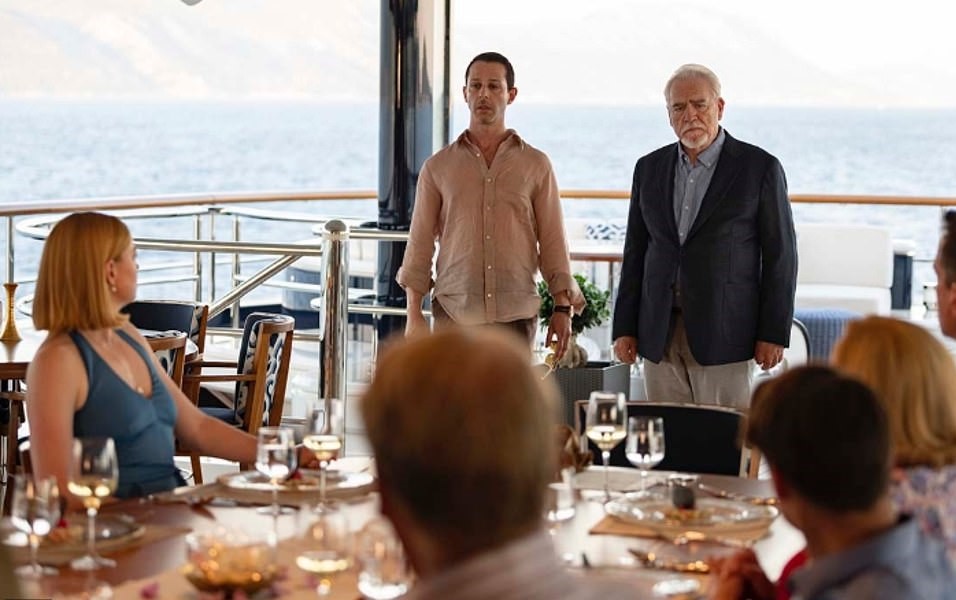 The Roy family aboard the yacht Solandge in Croatian waters © HBO
The Roy family aboard the yacht Solandge in Croatian waters © HBO
Now in its third season, Succession centres on the dysfunctional Roy family, owners of a global media and hospitality empire. It stars British actor Brian Cox as the ailing family patriarch with Kieran Culkin heading up the otherwise all-American cast. A total of 613 people worked on the shooting of Succession in Croatia, of which 595 were Croatian (161 film workers, three trainees and 431 extras).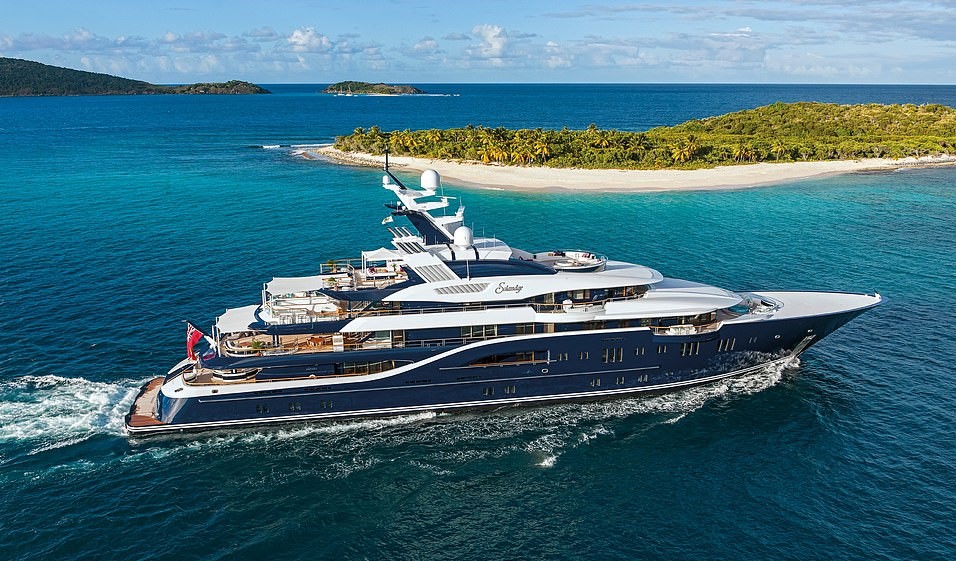 Solandge is currently one of the most luxurious yachts in the world © Moran Yachts
Solandge is currently one of the most luxurious yachts in the world © Moran Yachts
In recent years, major movies such as Star Wars, Robin Hood and one installment in the long-running James Bond series have joined the likes of Game Of Thrones and Mamma Mia in enjoying Croatia filming locations. However, filming in Croatia goes back much further than that. During the 1970s and early 1980s, no less than three Oscar-winning movies used Croatia filming locations - Fiddler on the Roof (1971), The Tin Drum (1979) and Sophie’s Choice (1982).
You can read more about filming in Croatia and Croatian filming locations by reading our dedicated section here
For the latest travel info, bookmark our main travel info article, which is updated daily.
Read the Croatian Travel Update in your language - now available in 24 languages
Join the Total Croatia Travel INFO Viber community.
PHOTOS: It's True! Beyonce and Jay Z in Croatia on Holiday
Total Croatia News broke the story last Friday. And now it's finally been confirmed - it's true, Beyonce and Jay Z in Croatia
News travels fast in Croatia. Nowhere does it travel quicker than on the ever-reliable News pages of Total Croatia News. Unless, of course, you count Croatian gossip.
TCN journalist extraordinaire Iva Tatić was relaxing on the island of Korčula, playing with her dog, when last week she heard an eyebrow-raising piece of gossip through the open window. “Beyonce and Jay Z in Croatia!”
Iva Tatić's dog, one of the first to hear about Beyonce and Jay Z in Croatia
Ever the professional, Iva leaned out of the balcony to ask a neighbour to confirm the rumour. “That's what they're saying” replied the neighbour, above a small street filled with laughter. The cause of the chuckles? Not only are Beyonce and Jay Z in Croatia, but they've also asked for the entire islet of Vrnik to be evacuated so they can enjoy a private visit. “Hmm, difficult request,” thought Iva. Vrnik is an inhabited island. People live there throughout the year. There are probably around 100 people there right now.
Much to the disappointment of her dog, Iva's journalistic instincts took over. She sat down at the computer and set about trying to corroborate the rumour so that she could break the news. At her time of writing, she was unable to do so. There was simply nothing in any other media confirming Beyonce and Jay Z in Croatia.
How Iva Tatić broke the story about Beyonce and Jay Z in Croatia last Friday. Her's was the first story to announce the pop star's arrival. It has since been confirmed that the celebrity couple are indeed aboard the pictured yacht, Lana. Iva Tatić took this photo of the yacht from the shores of the island of Korčula, where she likes to spend much of her summer
But, sometimes a journalist's instinct is all they need. Iva confirmed that the yacht Lana had been seen in the surroundings of the Korčula archipelago. She went to the shoreline and it was there! From a distance, she managed to grab a photo. At 107 meters in length and capable of accommodating 12 guests and 31 crew, this is no ordinary yacht. Some special visitors were definitely holidaying here.
Knowing that Beyonce and Jay Z had been here nine years ago, on Hvar, and two years prior to that had been in Dubrovnik, Iva went with gut instincts and published the story, being careful to mention it was uncorroborated. Her article was the first to break the news of a visit that is now 100% confirmed. It's true, Beyonce and Jay Z in Croatia.
Beyonce and Jay Z in Croatia, pictured on Instagram
The yacht Lana was spotted further up the coast on Saturday, around the Kornati archipelago. Then, in the afternoon of the same day, tourists visiting the island of Žut were finally able to corroborate Iva's story. They managed to grab pictures of Beyonce and Jay Z in Croatia. They were dining in an otherwise deserted restaurant, Fešta on the island. The visit coincides with Beyonce's 39th birthday.
Iva's story was confirmed by Croatian portal Zadarski.hr one day after Iva published when they were able to show photos of the couple dining on the island of Žut
This being visit number three for Beyonce and Jay Z in Croatia, we wouldn't count out a return visit next year for her 40th. The couple clearly love coming to Croatia. If they do come, be sure to look out for Total Croatia News again breaking the story. Since the writing of her article, Iva Tatić and her dog have been taking their cuddling sessions much closer to Iva's open window.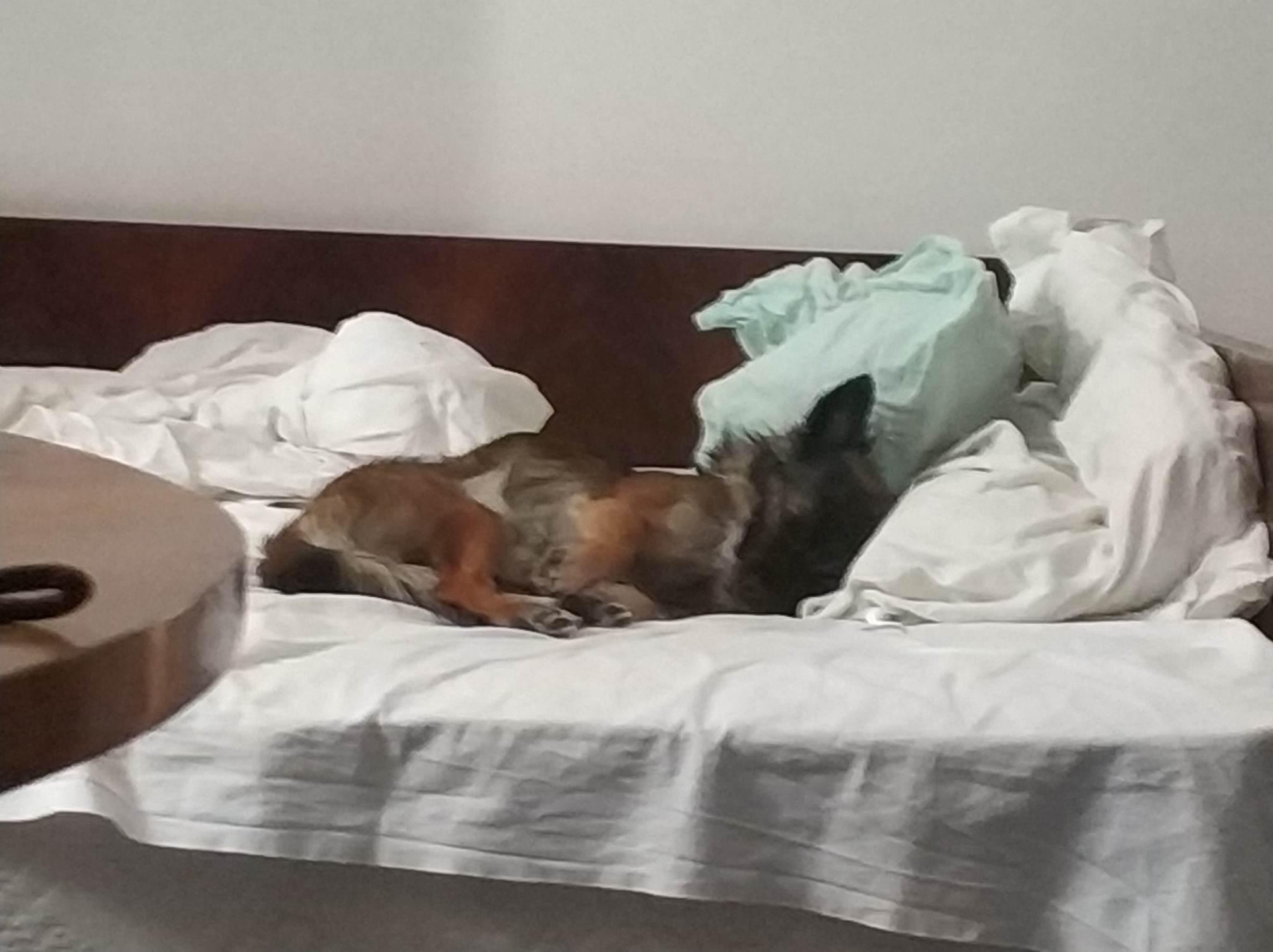
Iva Tatić's dog "Beyonce and Jay Z in Croatia? I don't care! Where did my cuddles go?"
For the latest travel info, bookmark our main travel info article, which is updated daily.
Read the Croatian Travel Update in your language - now available in 24 languages


